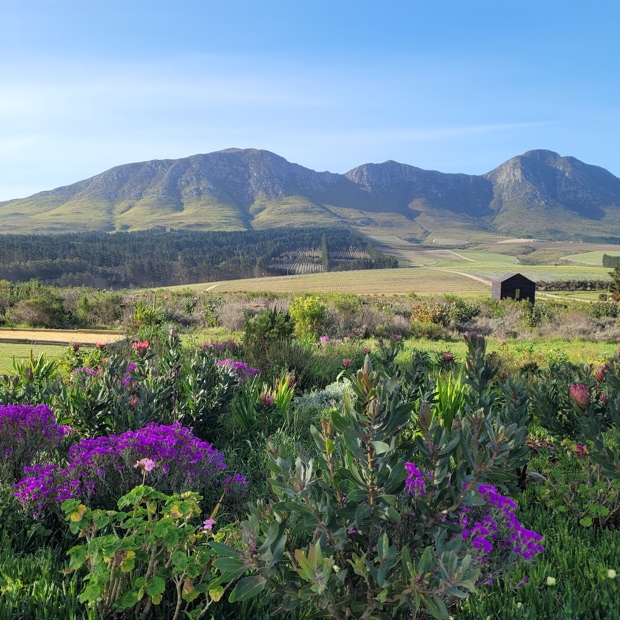
Hemel-en-Aarde
Regenerative and creative farming, old vines, new frontiers, 80 recommended current releases and braai brekkies
The phenomenon known as “seeing stars” is a common description for disturbances of vision, in seeing bands of light, prisms, sparks or flashing lights. The scientific name is photopsia, a fleeting state most often caused when temporary pressure is placed on the eye, like what happens when you sneeze or bump your head. Seeing stars has also become a symbol of positivity, happiness or renewal. A recent trip to South Africa’s Cape Wine 2022 brought about the literal meaning of the saying as it pertains to celebrity. Wine celebrity that is — and while most Cape personalities carry themselves in complete opposite character to that of an Afrikaans bekende persoon (famous person), their wines on the other hand might bring on that condition called photopsia. The individual flashes of light called phosphenes may cause dreaminess, giddiness and being weak in the knees. Spend nearly two weeks in South Africa for the Cape Wine fair and you are more than likely to find yourself seeing Western Cape stars.
Related – What comes next for the wines of South Africa?
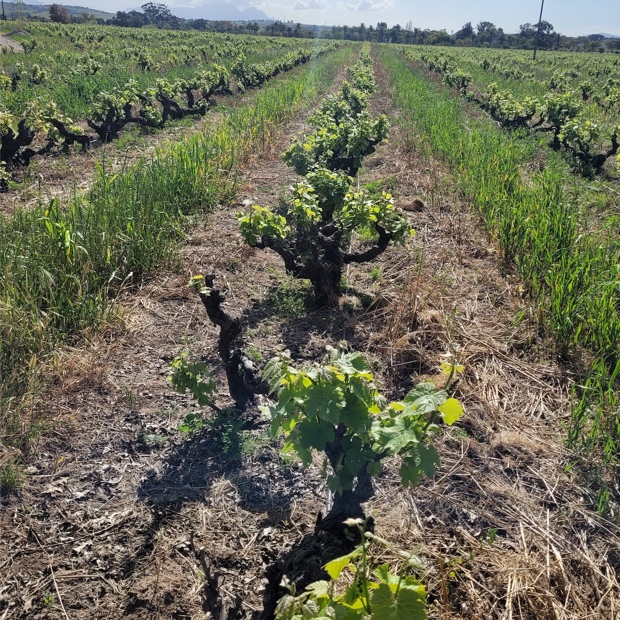
Old Vines FMC Vineyard, Stellenbosch
The Old Vine Project
In today’s Western Cape, discussions must begin with the entity known as The Old Vine Project. Over the past 20 years viticulturalist Rosa Kruger has focused on discovering, classifying, cataloguing and certifying heritage vineyards. It was a great pleasure to chat with Kruger at a Wines of South Africa ceremony and tasting at Cape Wine 2022, which celebrated her 2022 Decanter Hall of Fame Award. And also with the legend André Morgenthal, orchestrator of the tasting of old vines wines. It is remarkable to see how many estates and producers have come on board — to celebrate and show off the wines they are making from 35-year-old (and older) dry-farmed bush vines. Many vines are even pushing or exceeding the century mark.
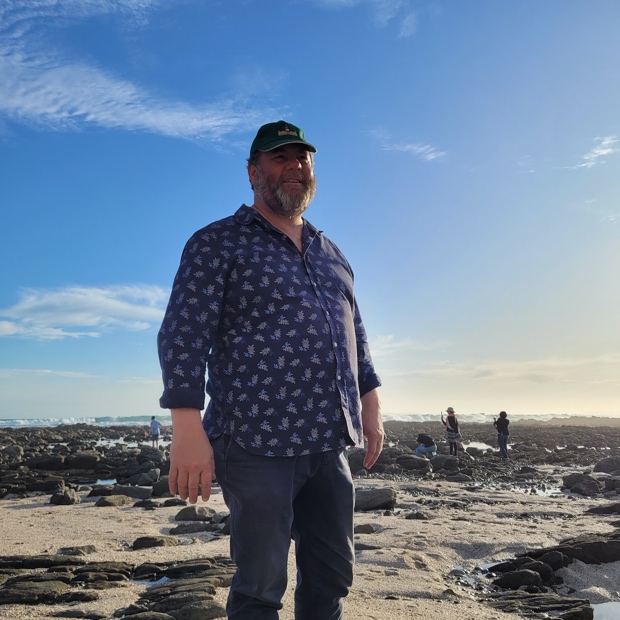
He is in fact larger than life – André Morgenthal, The Old Vines Project
“The old method is always the best, because…how did it get so old?” The words of La Motte’s Edmund Terblanche — and yet South Africa is really all about balancing the past with the present. This is why the PIWOSA group — Premium Independent Wines of South Africa — chose the thematic “something old and something new” for their event at Klein Constantia. Old will always be new again, reiterates Andrea Mullineux when she describes the Leeu Passant Old Vine Cinsault Lötter as “a national monument — that must be ripened. Either that or it’s sauvignon blanc and apricots.” Or worse — just apricots.
Preservation is key to the South African wine industry and heritage sites are the assets and the advantage. Chris Alheit is adamant about protecting heritage sites. “I mean, how can you not see this as a Cape treasure? As an ancestral site?” Thus, Alheit’s sémillon, once called La Colline, is also worthy of “monument” status — and though it may not seem to represent the literal definition of a “memorial stone or a building erected,” it does pay homage “in remembrance of a person or event.” In this case, the farmer — and every season of sémillon attempting to seek its fruition for the past 85 or more. Francois Haasbroek of Blackwater uses the term zeitgeist and, yes, the definition is equivocated through the idea of Western Cape single-vineyard wines from off the beaten path, small-parcel sites.

John Szabo MS, Roas Kruger, Godello and the photo bomber
So why are old vines important? Simply put, they are valued for acumen and complexity. They have moved past the imbalance and gawky stage, having achieved life experience, and now possessing profound things to say. Ten years ago, the Old Vine Project considered one per cent of planted vineyards as old, but the truth is 50 percent of old vineyards can be rejuvenated. Most are set into decomposed granite soils, in some instances colluvial as well. These tracts are really old and weathered, predating microbial life. The vineyards dot a landscape occupied by granite plumes exposed above the surface; where below the surface magma cooled ever so slowly and so there is now much more diversity in the life and texture of the rock. Some will wonder how the wines grow on the granite. Physically, the decomposed granite is very friable, and the soils are sandy, two to three meters deep. Roots can dig down, resulting in a bigger canopy — and under that dappled light (as opposed to daytime/nighttime sun), the grapes are able to retain acidity.
Related – Searching for great heart in South Africa

Chenin Blanc
Chenin Blanc and decomposed granite soils
The artist formerly known as Steen, now simply “chenin,” is as complex as chardonnay, with acidity like sauvignon blanc but never searing. For a passionate winemaker like Andrea Mullineux, the grape holds nostalgic qualities. In the Western Cape there are 17,000 hectares planted, more than double that of the Loire. From the 1960s to the ’80s, Lieberstein (a mass market, kitsch wine that launched a sort of South African renaissance) was the most successful wine brand. So much so the government put out a call to plant more chenin in the 1990s.
“When you have old bush vines, you’re going to get chenin blanc that harnesses sunlight, a thickening of the skins and an accumulation of full phenolic character — a taste of sunshine,” says Mullineux with that wry and sly smile. “Granite is the only soil that can give you this super reductive style with great energy,” explains Donovan Rall, who picks his chenin blanc early. “What we learned through the drought years is you don’t have to pick things as you were traditionally taught.”

Andrea and Chris Mullineux
As for recent vintages, 2019 had warm days and cool nights, allowing vines to relax and recover acidity. Then 2020 was very temperate with little diurnal temperature fluctuation, leading to quick yet relatively even ripening. In 2021 the season was cool but dry, though not with drought-like conditions seen in 2018. Veraison only finished in the second week of — quite opposed to previous years when picking was completed by the second or third weekend of that month. Yet 2021 allowed for more precision picking and quite a relaxed harvest.
In 2021 and 2022, vineyards in the Swartland achieved that elusive ideal of full phenolic ripeness. “We say phenolic ripeness, but we call it psychological ripeness,” notes Mullineux. “At least with respect to basing on numbers.” The ripening schedule follows a path starting in Roberston (which is inland), followed by Paarl, Franschhoek and the Swartland, then the coastal regions with Stellenbosch being one of the last, just ahead of Elgin, Wellington, Hermanus and Hemel-en-Aarde.
As for the Hemel-en-Aarde and chardonnay, Chris Albrecht from Bouchard Finlayson indicates that elevation on their side of the valley where fog and humidity settle at the lower levels play a direct role in viticulture and especially the ripening seasoning. Shallow shale soils overlaid with heavy clay is also a factor in determining grape maturity. The Valley has a plateau with an underbelly delivering unique sets of tannin, structure and acidity that, when mixed with sandstone and clay soils, makes for this aspect of how chardonnay sets up for individualistic display.
Related – Memories of South Africa in 60 notes

Fynbos, Vergelegen, Stellenbosch
The venn diagram of organic, biodynamic, sustainable and regenerative farming
Soils in South Africa are ancient and varied. There are three main types along with derivatives:
- Decomposed granites (oakleaf, tukulu, hutton and clovelly)
- Malmesbury, bokkeveld or witteberg shale (glenrosa, swartland, klapmuts and estcourt)
- Table Mountain sandstone (fernwood, longlands, westleigh and dundee)
Still other soils are major contributors to farming styles and the wines they beget. Alluvial, koffieklip, silica quartz, kaolinite clay, river gravels, klipheuwel conglomerates and shales, limestone and malmesbury clay are but a few. Then there are the plutons, dome-like intrusions of igneous magma into the earth’s crust which occurred at great depths and consequently cooled slowly, resulting in a coarse crystalline (granitoid) texture. These plutons have subsequently been exposed by erosion, resulting in mountains or hills such as those in Paarl and Perdeberg and the hills in Darling. In some cases, the exposed domes have been flat-topped by erosion and then covered with sandstone deposits, and have then again been eroded, resulting in sandstone on a granitic base, such as can be found in the Table and Simonsberg mountains. We must also point out the incredible Breede River Region’s characteristic calcareous loam soils and their association with bokkeveld and witteberg shales, dwyka tillite and enon conglomerate. In this part of the Cape it is Malgas that is the only South African wine area with significant alkaline soils.
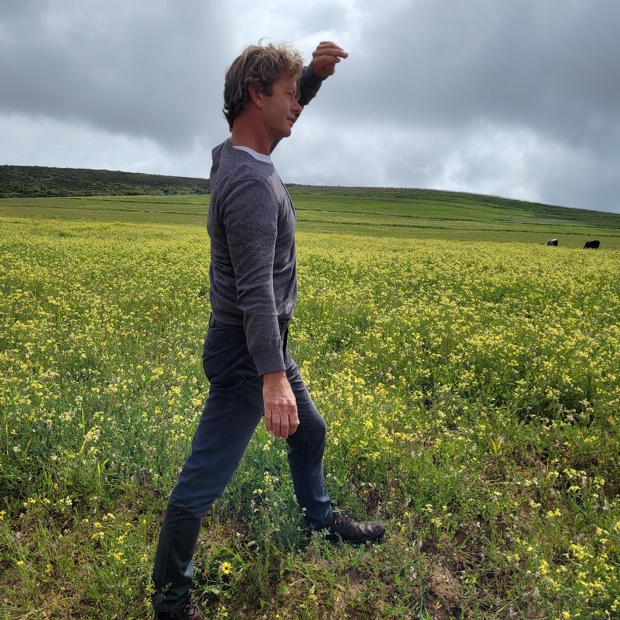
Johan Reyneke, Stellenbosch
Between the 1970s and ’90s, many of the old vineyards in the fancy regions like Stellenbosch and Costantia were ripped out to plant cabernet, merlot and pinot noir. This was not the case in the “sleepy” Swartland where many old vines, especially of the bush variety, remained untouched. Today a less obtrusive pruning method is employed on “goblet,” which means smaller canopies, lower yields and less water requirements. This method reduces susceptibility to wood rot and also Esca, one of the complex of “trunk diseases” (along with Botryosphaeria dieback, Eutypa dieback, and Phomopsis dieback) caused by wood-infecting fungi.
“We’re figuring this out and it’s getting fun now,” says Callie Louw. But Louw is the anti-hero, the man who focuses on one large entity. “Working with all these little bits of grapes here and there is not sustainable,” he says, and so 90 hectares produces 850 tonnes of grapes with 85 per cent going into (Boekenhoutskloof) Chocolate Block. “We don’t need to offset climate change with varietal adaptation. We just need to farm better. The problem doesn’t go away. Cover cropping, activate your place, get things growing, the whole profile is run in the top four inches. Below is the bank, the reservoir, the thing that makes the money is on top. Stop tilling! Leave that stuff on the top of soil. It just burns. Keep the active things alive. Increase the carbon in your soil by one per cent and the water will increase by 50.”

With Callie Louw, Porseleinberg
At Vergelegen Wine Estate in Somerset West it is environmental manager Eben Olderwagen who shows how abrasive yellow vine trunk wraps are employed to repel geckos and slugs in lieu of spaying. This sustainability action is part of Vergelegen’s track record as a wine estate renowned for its biodiversity and commitment to environmental sustainability. (Vergelegen is owned by mining company Anglo American.) The recent completion of an extensive programme to rehabilitate eroded watercourses is now the stuff of Western Cape legend. Five sites saw the removal of invasive alien species like Blue Gum trees (between 2004 and 2018) and the replanting of some 15,000 indigenous plants that were housed temporarily while the programme was underway. The 12 million Rand project has saved rehabilitated wetlands and Lourensford Alluvium Fynbos vegetation, which could have been badly affected by sediment washing onto the area. In addition, it has halted sediment contamination of the Lourens River, part of which runs through the estate. Rare vegetation discovered by botanists on the property thought to be extinct has been preserved within the hills and valleys of the 2,000-hectare nature preserve. In 2009 a major fore swept through and burned much of the vegetation, but this is actually beneficial to the fynbos which needs a good burn every 12-15 years for proper rejuvenation. No municipal water is used on the property as water from the Helderberg Mountain is captured in two damns. Vergelegen lays claim to now being the most leaf-roll virus free in the Western Cape.

Johan Reyneke
“Land caring, land sharing and making quality wine” is Reyneke’s tripartite platform and both story and also that of the cows is like a tree with different branches. The animals graze in high density, moving throughout the year from block to block. They graze and return microbes back into the soil, through their waste and create humus. Vines are fed by this regenerative activity. Dandelions are planted to attract pests so they will leave the vines and roots alone. Downy mold is managed with metabolic enzymes of copper, not always successful on its own but fighting alongside the humus offers a much better chance of control. Not to mention brix levels are raised because of this type of farming. Land sparing essentially means that if you have ecologically endangered endemic plant species you must leave them to live in conjunction with your vines. Don’t reduce them. And for goodness sakes don’t till.

Chenin Blanc, Reyneke
Thankfully by this point roughly 90 percent of farmers in the Western Cape have converted to no-tillage systems to improve the efficiency of crop production. Reyneke also plants new vineyards on contoured angles to control winter water flow but also erosion so that the flow will reach the property’s two dams. There are the fynbos “corridors,” between the blocks to allow wild animals a chance to remain in nature. This all adds up to creative farming mixed with regeneration and sustainability. The first seven years of this policy have all been about renewing the soils and each year the goal is to plant between five and seven new hectares, with 30 on schedule to go in over the next five years. “It begins with organics (which is sustainable), then graduate to biodynamics (which is self-sufficiency) but there is a constant struggle between caring and common sense.”
In other words decisions have to be made, economic ones, to support family, workers and the farm. “People have different tools during different epochs to deal with reality. Science is not about being certain and sometimes it’s about being doubtful. I’m never sure 100 per cent.”
These are the words of Jolandie Fouché of Wolf and Woman Wines: “As shared custodians of the lands that house these vineyards, we also ensure that we partner with growers who farm sustainably in order to produce top-quality grapes without compromising the environment, and the vineyards themselves, in the long run.” And there is Marlise Niemann who recreates the taciturn through gestures so befitting her Momento wines. They like so many of the Western Cape endure for their balance between place and adventure, as well as remaining grounded through their maker’s independence and relationship with the tracts they choose to interpret.
Related – Around the Cape in 50 wines

Agulhas
Appellative blends in red and white
There are reasons why many Western Cape winemakers increasingly turn to accounts spoken in stacked varieties through appellative blends. Not because it can be a French thing to do in the ways of Châteauneuf-du-Pâpe but because it makes for wines possessive of immense character.
“We need these wines and to pay a lip service to them is essential,” says Adi Badenhorst. “As a winemaker or in any homestead job you are always influenced by where you grew up and who you worked with. In the Swartland these are the varieties that were there.” Badenhorst’s ideas are echoed and expanded upon by Duncan Savage. “All the wines are directly connected to their sites,” he says. “That shouldn’t change too often. The farms are big here so you can’t afford to own 50 hectares.” Thus, a winemaker and producer like Savage picks their plots and develops their relationships with their fruit over long periods of time.

After the Cape Wine trade fair, we rode over dirt and dust to what felt like The Western Cape’s version of the outback, to arrive near Malgas up above the Breede River just 15 kilometres in from the Indian Ocean at South Africa’s most southern tip. This is the remote and “insane” home of Sijnn Wines (pronounced “sane”) where visionary David Trafford saw the future a few hours away from Arniston and Cape Agulhas. The beautifully shaped and hued river stones (aka, puddings) and Bokkeveld Shale are perhaps the world’s greatest impetus for developing Rhône varieties à la Châteauneuf-du-Pâpe.
Yet this is South Africa and so chenin blanc, verdelho, touriga nacional, trincadeira and cabernet sauvignon also thrive despite the poorest of soils. Winemaking in the hands of Charla Bosman sees a prodigy and savant at one with the land so that the progression from 2015 vintage through wines resting in barrel today may as well be a decades long discovery.
Related – Welcome to South Africa’s Capelands

With Charla Bosman
Why South African producers must sell their wines abroad
There can be no begrudging people who might imagine South Africa as a growing area of sunshine, heat, and potentially high-alcohol red wines. That is why they must be shows how so many phenolically ripe red wines lock in at a low, low 11.5 to 12.5 percent alcohol that seemingly only the Western Cape can affect for grape varieties like cinsault and grenache.
“I’ve never worked with conversion rates this low,” says Donovan Rall, and his cinsault is a testament to the excellence and magic of vintage. “With no compromise to flavour, tannin, acidity and length.” The low alcohol at 11.8 is brilliant, as no push to ripeness was needed to achieve these heights. Mick and Jeanine Craven manage to create this impossibility with cabernet sauvignon, while still delivering ripeness, generosity, and peace of mind. Another bit of voodoo magic from a place and a maker that knows what’s what.

Cape Town
The need to export, to reach as many new customers in as many countries as possible is the challenge for South Africa’s producers. The Cape Winelands are oceans and continents away from most markets and that remains a serious obstacle, not to mention being situated at the southern-most tip of Africa. The isolation was devastating during Covid, compounded by governmental decisions rooted in prohibition, isolationism, and fear. But the world has re-opened to South Africa and seeking representation beyond Europe is necessary, including finding markets in Canada.
Says Eben Sadie: “There is now a healthy competition between producers. There are vineyards that I planted 10 and 15 years ago that I can now say great things about. It’s in the glass. It’s kind of our time now. We have 3,000 people in this country buying fine wine. Guys who are willing to pay $50 to $60 a bottle for wine. We are all selling locally to the same group of guys. The local market is brutal.”
Related – Once upon a time in the Western Cape
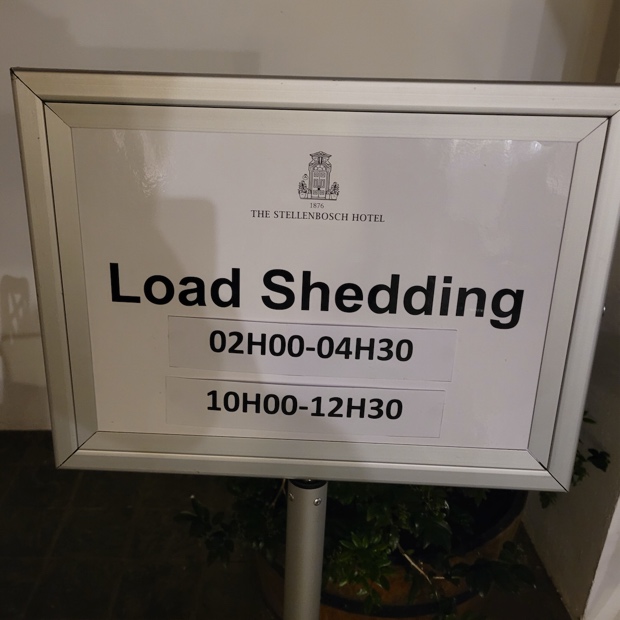
How the Western Cape was won
Cape Wine 2022 was my third trip to South Africa’s winelands between 2015 and 2022. That first congress in 2015 opened my eyes to the possibilities of a wild west experience where the planet’s most ancient soils and geography were able to host grape varieties from all over the world. It seemed like anything could ripen anywhere agriculturalists chose and winemakers wished for. Three years later it was understood that what and where you plant was the key to producing great wines of a sort being made nowhere else in this world. This last journey changed everything again and now it is the coalescence of heritage vineyards, magical conversion rates, sustainable and regenerative agriculture that separates South Africa from all the rest. The Western Cape may be an isolated wine industry and exporting the most challenging of any wine producing nation, but these wines must make it onto our shores. They are too good to miss, not just a handful but hundreds of outstanding examples. Quality has risen exponentially, virtually across all places of origin, including new frontiers. The stars are out, and they are aligned.

Braai Brekkies, Franschhoek
Godello’s 80 recommended current releases
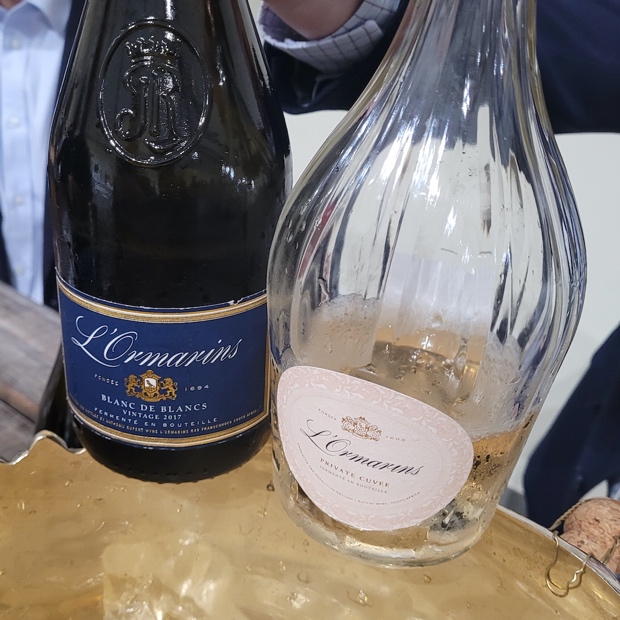
Cap Classique
Anthonij Rupert L’Ormarins Cap Classique Blanc De Blancs 2017, WO Western Cape
Drought vintage no matter nor adversity for this 100 per cent chardonnay aged four and a half years on the lees. Palate presence and texture synthesis but also a really sharp bubble of aromatics in lemon zest, ginger and spice. Elegant and sensory, of sips drift worthy for daydreaming and calm. A blanc de blancs of sanguine personality, extroverted, social and active so that you don’t have to be. Good times when a Cap Classique can do it all, leaving you to enjoy, relieve stress and relax. Seventh iteration heaven from a program that began back in 2017. Drink 2022-2026. Tasted October 2022
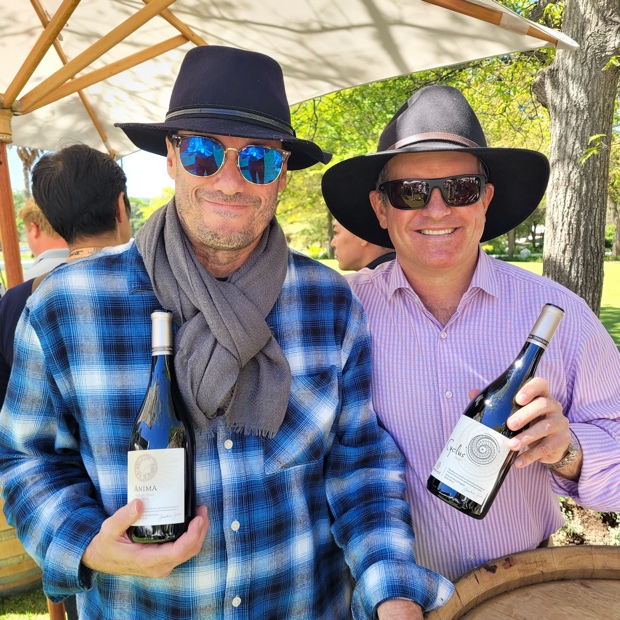
With Johnathan Grieve, Avondale Wines
Avondale Armilla Blanc De Blanc 2015, WO Paarl
From the tradition of Méthode Cap Classique Armilla is a Blanc de Blancs in 100 percent chardonnay, seven years total on the lees, 90 percent in stainless steel, (10) in big French for one year in barrel. Two of the years on the coarse lees were in tank and all is natural. First vintage was 2003. The only thing that has really changed is the extended lees aging but not the moorish acidity extending the freshness and eliciting a keen sense of brioche. The 3 g/L dosage is negligible and so from start to finish Armilla retains its aridity, is never stark but always balanced. More sugar would make it big and fat and see it lacking brightness which frankly is this B de B’s calling card. Resides at the upper echelon for Cap Classique. Cracker stuff. Drink 2022-2029. Tasted October 2022
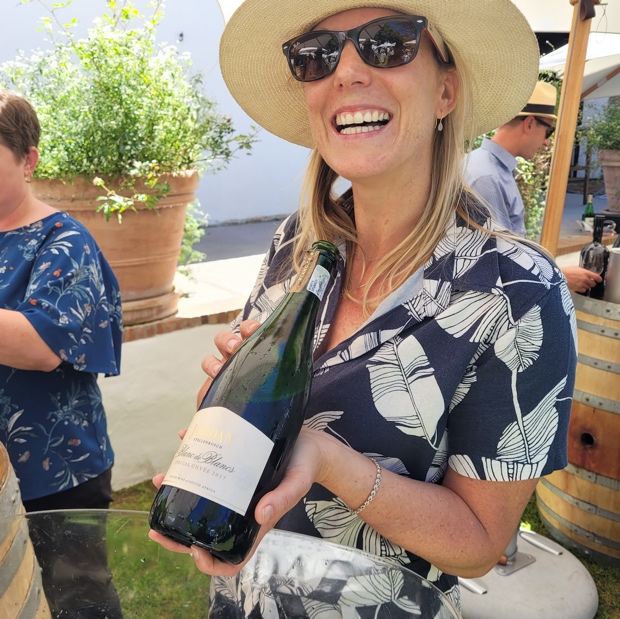
Jordan Wines Blanc De Blancs Special Cuvée 2017, WO Stellenbosch
A brilliant all in chardonnay Cap Classique from 22 year-old vines growing on Glenrosa and Hutton soils abutting the Stellenbosch Kloof. A Mediterranean climate here, only 24 kms from the ocean at False Bay. Breezes channel in from the West Coast’s Benguela current and it’s not just a repeated adage to say that the Atlantic winds translate into crazy open-air freshness in Jordan’s scintillant of a white sparkling wine. Spends a nurturing 54 months on lees and this bottle is from the second disgorgement, just now in October of this year. First vintage was 2015 and this is just the second for a B de B bubble that will join the ranks from MCC through to CC’s finest. Sharp yet delicate, intensely focused, precise, with citrus squalls and in the end a treat and a dream. Drink 2022-2027. Tasted October 2022
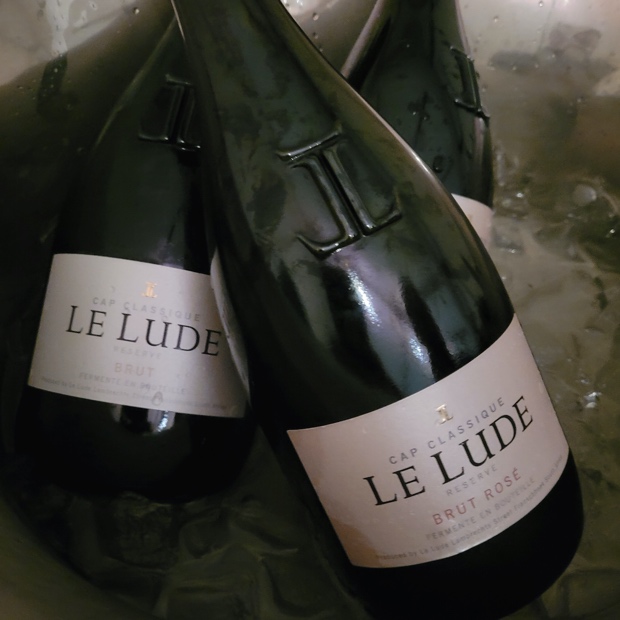
Le Lude Brut Reserve Cap Classique NV, WO Franschhoek
I mean, just classic. Citrus juiced and a ripeness in this particular cuvée, always ahead of the curve and also the Rosé. Nothing taking for granted, sharp and superlative acids causing the chardonnay to flourish, intensity heightened as far as one could wish. Even keeled, never expressing highs to high or lows to low. Last tasted October 2022
The blend is with pinot noir but in this sister cuvée to the Brut Rosé it’s really about what chardonnay is going to bring to the MCC table. The dosage is just slightly higher than the Rosé, here at 6.5 g/L and 24 months on its lees. Here the shift is towards more richness, almost counterintuitive when you think about blanc vs. rose but Paul Gerber is on to something big. There is a plum compote luxe note stirred into the citrus and so both ends of the fruit spectrum are involved and incredible. “You must taste the sun in the fruit,” insists Gerber, sparkling wine or not and so with verve, intensity and balance this travels to terrific and back. Drink 2018-2022. Tasted September 2018
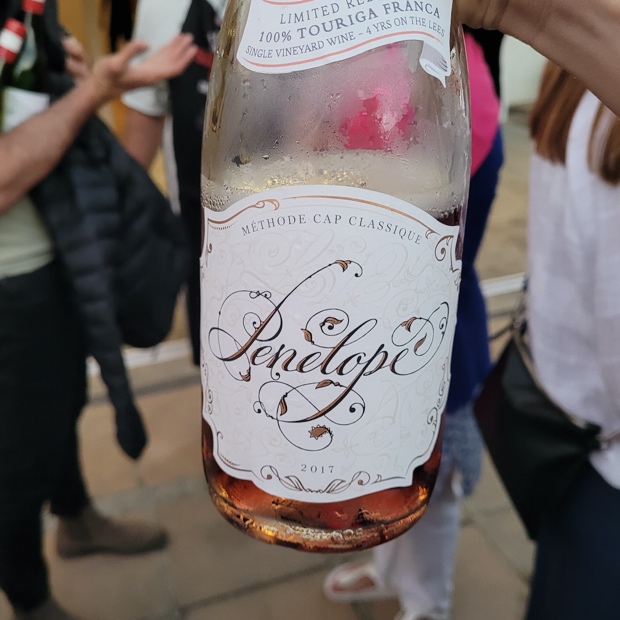
The Drift Estate Penelope Cap Classique 2017, WO Overberg Highlands
Penelope by Bruce Jack is 100 percent touriga nacional, first ever in existence as sparkling wine, likely not just in South Africa but anywhere in the world. Also a single vineyard Cap Classique and as crazy a perfect storm of variety and methodology as there has ever been, almost outdone by Jack’s ice bucket and Penelope story when the earth stopped. Go to the website for more details. This CC is raging though the specs are not exceptional and so some sort of Cape voodoo is happening here. The farm is too cold to really get a ripeness converting above 11.5 percent alcohol so sparkling it is and the 20 year-old vines deliver the necessary fodder for top notch sparkling Rosé. Goes all currants and ginger, rooibos and fynbos. As it must. Drink 2022-2025. Tasted October 2022

Old Vines
Alheit Vineyards Sémillon Monument 2021, WO Franschhoek
The artist formerly known as “La Colline” received a name re-branding in the previous vintage yet the source and the song remain the same. That being the 1936 planted (and registered) heritage sémillion vineyard but the farmer passed away in 1938 so the block could actually be as much as two decades older. “Diversity is a matter of having the genetic material to do it,” explains Chris Alheit “and though there may be drifts away from the original DNA, there will always be that connection.” Oldest indeed within the quadrangle composed of Paarl, Wellington, Franschhoek and Stellenbosch. “I mean how can you not see this as a Cape treasure? As an ancestral site?” Thus the new moniker and though it may not seem to represent the true definition of a “memorial stone or a building erected” it does in fact pay homage “in remembrance of a person or event.” They being the farmer and every season of sémillon attempting to seek its fruition for the past 85+ seasons. As for 2021 the imprint just feels like a culmination, of fruit speaking in historical terms and bound to structure, of acid, tannin and extract all constructed as confidentially as ever there has been afforded the opportunity. The 2021 Monument is a rock as profound and important as any sémillon anywhere. “Yeah, people don’t you listen now? Sing along, Oh. You don’t know what you’re missing, now.” Drink 2024-2035. Tasted October 2022
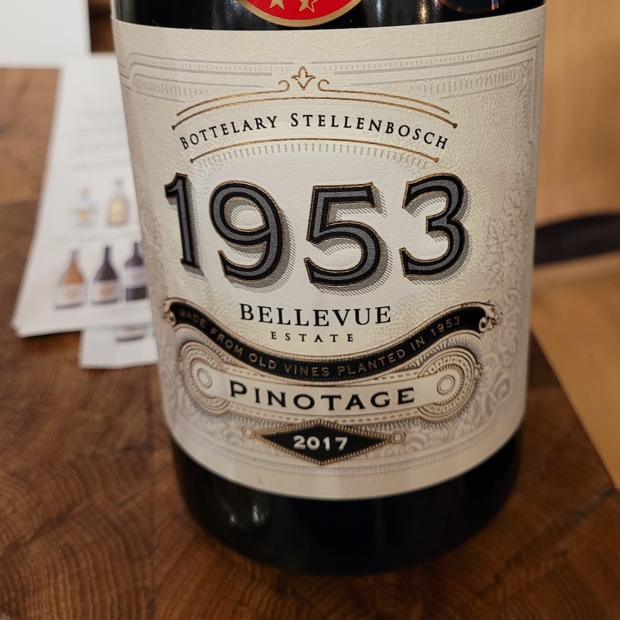
Bellevue Estate 1953 Pinotage 2017, WO Stellenbosch
A remarkable wine to have the opportunity to taste from vines aged 64 at the time of this vintage and interpreted by winemaker Wilhelm Kritzinger. Bush vines, their yields less than one tonne per hectare (in drought years, of which there are many), upwards of 1.75 in the best of times. The location is Bottelary in Stellenbosch and Bellevue seeks gradual extraction, not quite a full on délestage but the whole lot is transferred from vessel to vessel. The normal press time is seven days and this rare pinotage is always fermented fully dry. Sees 23 months in well versed and rehearsed wood for what is tops in terms of experienced and developed pinotage. Secure in character, prepped and purposed in personality, in delivery of the bloody and the iodide, part soil and part ocean water. A metabolic wonder, converter of energy, meticulously made. Total pro with a whole lotta good dark salted chocolate upon the finish. Drink 2023-2027. Tasted October 2022

Penny Noire, Cape Town
Boekenhoutskloof Sémillon 2019, WO Franschhoek
Tasted with Lynton Kaiser of Boekenhoutskloof and this three vineyard sémillon blend out of this vintage elicits the kind of looks and gestures requiring no words. The 1936 Franschhoek planted La Colline provides half the fruit (with a good portion having mutated into sémillon gris) and the other 50 percent coming from a 1942 site set into the ancient Franschhoek Riverbed, but also including a few points of muscat out of a block planted in 1902. Concrete eggs house 30 per cent of the ferment and neutral barrels do the yeoman work to keep this cuvée in a primary state for what will likely be a minimum eight to 10 years. The bones are hard and unbreakable to indicate structural propriety and so seeing a decade pass is a near guarantee before next level complexities and brilliant complications will appear. For now there is intrigue, the promise of lemon curd, beeswax, toasted lemongrass and the sort of exotic herbs you’d tear into a bowl of aromatically charged southeast Asian broth. Top and benchmark in so many ways, easily deserving of its reputation. Drink 2026-2035. Tasted October 2022

David And Nadia Wines Chenin Blanc Hoë Steen 2021, WO Swartland
Hoë-Steen is one of four single vineyard chenin blanc from a terroir in the “which one of these things is not like the rest” set of propositions. Planted in 1968 to see it recently cross the half century mark and soils are unique, especially as it pertains to chenin blanc. They are red iron oxide clay, rich and deep, location west of Malmesbury direction Darling. The label reads chenin but truth is a few other surviving vines here and there are in the yard, including discoveries of riesling (crouchen blanc), false pedro, palomino, sémillon and clairette blanche. And who does not appreciate the heritage and concept of a field blend? They’ll call them zinfandel in Sonoma but many are layered of a similar ilk, with the likes of grenache, alicante bouschet, petite sirah, mataro and others playing in the band. Hoë-Steen’s adept water retention and cool temps below the surface put this dry-farmed SV in a place of slower phenolic development and longer growing seasons. The effect on chenin is enchanting, divinatory even and never what you fully expect. Round is not the thought because the trinity of fruit, acid and tannin touch all points, in sequence and exact intervals. The wine can keep time and also plays in fills between the lines. It is symphonic, the whole package, in synch. Drink 2023-2034. Tasted October 2022

Nicole Kilian, Keermont Wines
Keermont Chenin Blanc Riverside 2019, WO Stellenbosch
Keermont is the Stellenbosch farm of Mark and Monica Wraith with their four children. Alex Starey takes care of the vineyards and is the winemaker. This 2019 Riverside was tasted at the Old Vines Project evening with Nicole Kilian who happens to be an American married to a Canadian and their work is purely South African. The 1971 planted single vineyard is the third oldest chenin plot in Stellenbosch. The ’19 was barrel fermented and spent a year in well seasoned oak. The result is purity incarnate, from old vine chenin that has endured nearly 50 years and it just seems like this is the kind of wine that makes itself. The barrels add subtle smoulder and bright luminescence but nothing in terms of density or maturity. A beautiful thing when chenin glides like this and one that will surely sail slowly towards the sunset. Drink 2022-2027. Tasted October 2022

Ken Forrester
Ken Forrester The FMC Chenin Blanc 2021, WO Stellenbosch
Really different vintage as compared to 2019, here the FMC is a matter of something definably sapid which would indicate the pH being slightly higher while the acidity is just a bit levelled. The wood elicits density and as a result there is a depth to 2021 that stands apart. Fruit concentration while special is not the solo driver because pH, natural fruit sweetness and texture are what make ’21 shine. The youthfulness will confuse the situation and it would seem that eight to 10 years will be needed to settle this score, like Kabinett riesling, Hunter Valley sémillon or any number of Cape old vines chenin blanc. Drink 2024-2031. Tasted October 2022

Cinsault is the grape planted after phylloxera, which started its devastation around 1900. The idea was essentially to replant all that was lost. The Franschhoek vineyard went in back in 1932, placed upon the mid-slopes, close to but not quite on the valley floor. The Mullineuxs started leasing the block in 2014 and are committed through 2034. This is higher up in these foothills facing west and produces some of the darker cinsaults in the Western Cape, relatively speaking, but especially in contrast to the Wellington (Basson) vineyard. Ethereal and elegant in spite of the shade, more fruit substance and also textural elements. Lötter is the one in this regard, effusive and generous, a wine of soul, soil, history and heritage. A cinsault in the prime time of its epic journey as Andrea Mullineux describes its host as “a national monument that must be ripened. Either that or it’s sauvignon blanc and apricots.” There are two hectares of really healthy and hardy plants, once nearly lost to the sands of time. Drink 2022-2028. Tasted October 2022
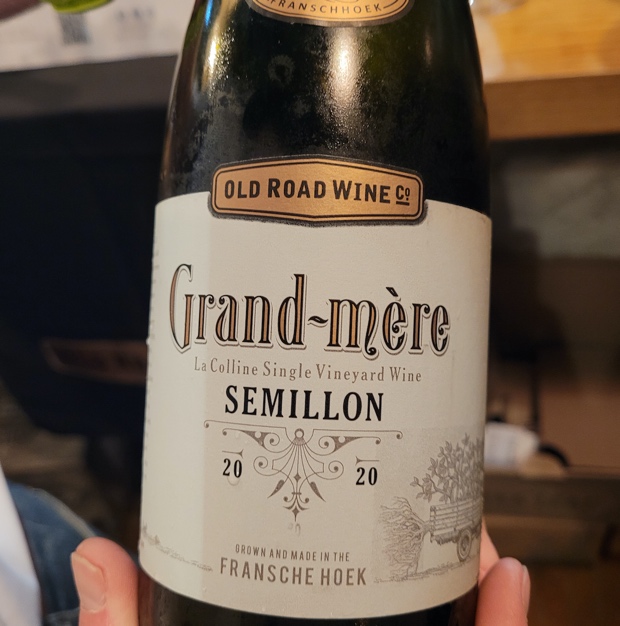
Old Road Wine Company Sémillon Grand Mère 2020, WO Franschhoek
From the vineyard known as La Colline, a high density Franschhoek plot planted back in 1936. Chis Alheit also uses some of this sémillon and now calls his old vines “Monument.” The Old Road Company chooses the name “Grand Mère” which is precisely what the incredible heritage block is for vineyards that have stood the test of time. Crops at a mere three tones per hectare and delivers the most steely and flinty sémillon on the planet. La Colline is southeast facing at 350m, housing unirrigated bush vines and experienced to the effect that a winemaker must not try to dictate its direction. Grapes are left on the skins overnight and 30 percent are allowed to run through a wild ferment. Barrel maturation in mostly older French oak on the primary lees with regular stirring induces a coagulation of creamy texture to offset the striking metal sensation in the wine. On the boozy side but the vintage and the vineyard truly dictate the course. Will age really well, likely well into the next decade. Drink 2023-2032. Tasted October 2022
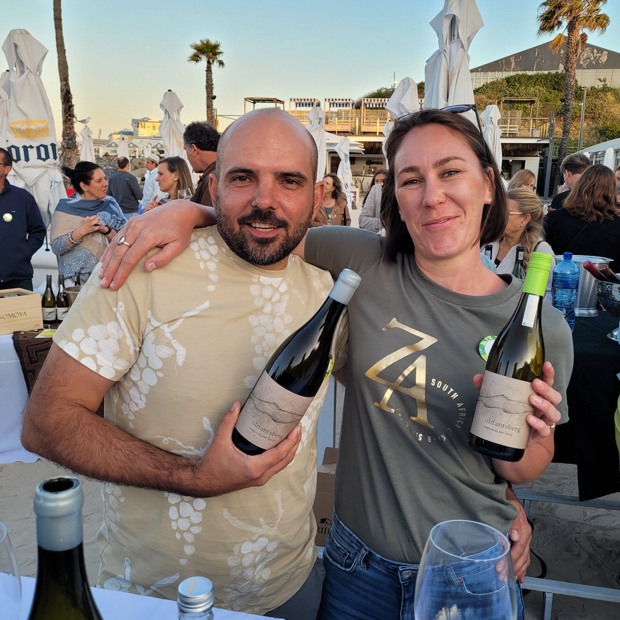
Ferdie and Elizma Visser
Olifantsberg Chenin Blanc Old Vine 2022, WO Breedekloof
From Ferdie and (winemaker) Elizma Visser in the Western Cape Breedlekloof (part of the Breede River Valley) at 450m above sea level. The soils are sansdstone and shale with rich alluvials and river rocks for a complex earth from which 1982 planted (certified) old bush vines deliver this exceptional chenin blanc. Olifantsberg was established in 2003 and in just two short decades this producer has connected with their surroundings so tactfully as witnessed in this varietal wine. Now here is something you need to know about, of purity by chenin and a s much rich texture you will ever encounter. Comes equipped with all the minerals and elements of this diverse terroir darting and dodging flesh to preserve and heighten freshness. So Chablisienne in chenin blanc terms, at Premier Cru level and rising. Wow. Drink 2023-2029. Tasted October 2022
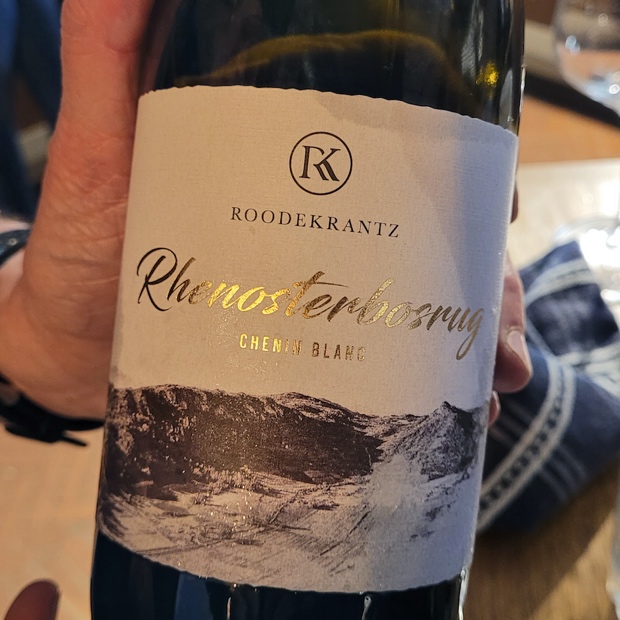
Roodekrantz Chenin Blanc Old Bush Vine 2021, WO Paarl
The 1974 vineyard is dry-land, bush vine on deep decomposed Malmesbury shale with more rocky parts than clay-based underlay. “One of the more sought after blocks,” says Marius Burger. “A fight for just a few rows.” He and winemaker Danie Morkel have been interpreting this chenin blanc fruit since 2017, to make this 2021 number five. The vineyard inclines with quite the ungraded slope so it’s hard to pick it right. “Parts of the vineyard have creaky bones in the mornings but we’ve man aged to get it right by now.” This is chenin of a brilliant tenor, bass note placed just below the treble, finding equalization. The fruit shows tempo, mixing with texture to share likeminded frequencies with rhythm and pitch. Just a focused chenin blanc handled by the drogaman wholly respectful of a vineyard’s 47 years of experience. Drink 2024-2029. Tasted October 2022

The Sadie Family Die Ouwingerdreeks Mev. Kirsten Wyn Van Oorsprong Stellenbosch Die Sadie Familie Wyne 2021, WO Swartland
The vines that supply Mev. Kirsten Wyn are the oldest chenin blanc in the country, out of Stellenbosch and planted in 1905. In 1947 every second row was pulled out to make room for tractors and the configuration still exists this way. “If South Africa has a true apex white Grand Cru vineyard then this is it” insists Eben Sadie. Facts are facts are you just can’t accede these levels of power, concentration, extract and tannin anywhere else. The nose communicates as an intoxicant of sublime forces and these grapes bestow chenin blanc 2021 are those that transcend fruit, deliver ethereality and a heightened sense of awareness. An awakening from necessary tension, crisis and personal freedoms, existential off the charts, poetic and epic. One hundred and sixteen stanzas recorded, in the books and the finest verse written right here in the most recent vintage. If enlightenment is to be gained from chenin blanc in the Western Cape, Mev. Kirsten would provide the fodder. “The grail. End of fucking story” concludes Sadie. All hail. Long live the queen. Drink 2025-2040. Tasted October 2022
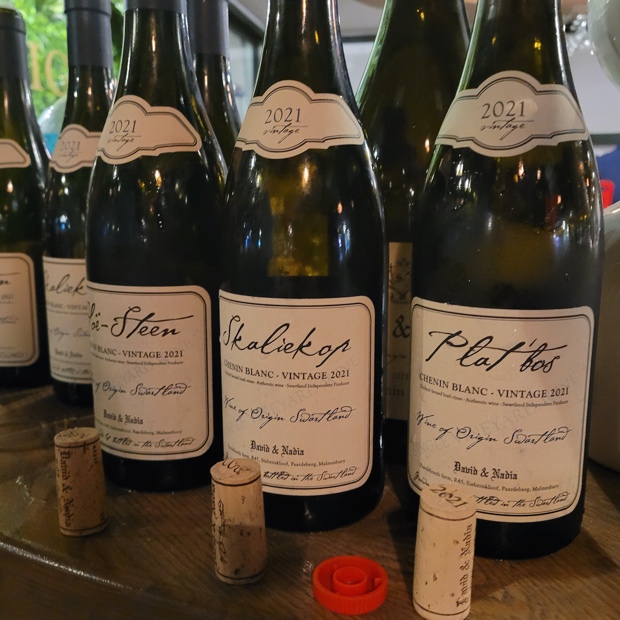
Chenin Blanc
David And Nadia Sadie Wines Plat’Bos Chenin Blanc 2021, WO Swartland
At a tasting where everything is Old Vines Project certified there must be something extraordinary about a wine to stand out from a crowd of greats. David and Nadia Sadie are in fact turning heritage vines chenin blanc (amongst other varietal explorations) into content born of context harboured though never paraded. They are rhythmic and scientific with just enough fantasy and romanticism, but never too much. Plat’Bos stands above Skaliekop and Hoë Steen because 2021 asks it to do so, not because it is better or more important, but it is surely chenin blanc profound. The 1981 Swartland planting is in the steady zone, shed of the mercurial and in ’21 so very linear yet salty of the earth in its sombre-sepulchral tone. There is reduction here because the poor soil nutrients demand that this chenin begins this way. The levels of tension and intensity are most elevated, sufficing to say as high as any from the Western Cape. Attention is paid unwavering to detail, sequencing is in order, purity incarnate, grape and place together pristinely kept. In Plat’Bos 2021 the palate is taken down to the whipping post by a wine built to endure. Given time there will be calm, healing and reward in the end. Drink 2024-2036. Tasted October 2022
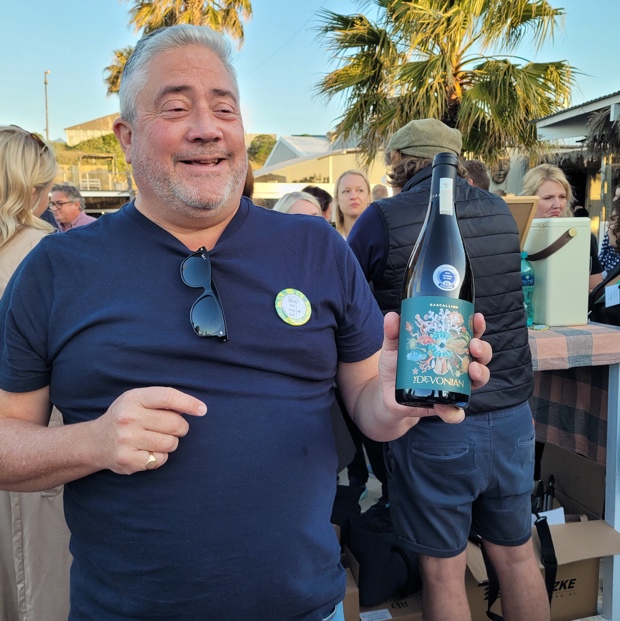
Rascallion The Devonian 2021, WO Swartland
A small production of 100 percent Swartland chenin blanc from old vines planted between 1968 and 1982 and at this price ($32 CDN) it solicits an “are you kidding me?” reaction. Bloody rich and concentrated yet so balanced without any slide into metallic or boozy character. Expertly managed with all connective tissue tied to the decomposed granites of the Swartland, blessed of true expressive nature, pulsating and alive. The energy is buzzing and its impressive in the way it grabs, demands and keeps attention. So hard to turn away or think about anything else. Drink 2022-2026. Tasted October 2022

Theunis Kruger
Theunis Kruger’s natural chenin blanc from a 1987 or 1988 planted vineyard comes away in one pick and is put to large (15 year) old foudres of 300-400L. He and we agree that this represents the most important grape (Theunis uses the word “best”) and yet they are not all created equal, including this coming from Citrusdal Mountain. Cracks the whip and works the palate like it means business, knows what wants and also what needs. The race of acidity will carry forward for quite some time. Drink 2022-2027. Tasted October 2022

Holden Manz Chenin Blanc Reserve 2019, WO Stellenbosch
Spent nine months on lees, fruit from 43 year-old vineyard on the Simonsberg side of the Helderberg Mountain. A bit further up the valley en route to Franschhoek. Made since 2010 (by Gerard Manz) with a rich and viscous meets metallic chenin. High level of concentration in a high-caste style. No lack of barrel accentuation and well made. Drink 2023-2027. Tasted October 2022

Kleine Zalze, Stellenbosch
Kleine Zalze Chenin Blanc Vineyard Selection 2021, WO Stellenbosch
Wouldn’t call this ulterior but there is something curiously upticking, visceral and unique as it pertains to Stellenbosch chenin blanc. Not simply a matter of richness but a varietal wine that elicits a rise of emotion, especially out of flavours and textures with barrel fermentation acting as the catalyst. Buzz of energy yes but also a buttery syrup sensation derived and you could just pour this over your morning pancakes. Not because of sweetness but instead complexity, stylish personality and as they say, deliciousness. Also looking for some fatty protein so pulled duck leg and blueberry on those flapjacks and a glass of chenin blanc will do nicely thank you very much. If you want a chardonnay alternative with less apples and brioche this is the way to go. Drink 2022-2026. Tasted October 2022

L’Avenir Estate Chenin Blanc Single Block 2021, WO Stellenbosch
Notably concentrated by naturally sweet chenin blanc fruit inclusive of the 1971 planted Stellenbosch vineyard. As a comparison to the Far and Near chenin it’s as if everything accentuates and comes into clearer view. Feels a touch advanced and mature beyond its short time after harvest and my if this just speaks the varietal language of Stellenbosch. If you like the normal then you will come to appreciate the reserve, aka the Single Block. Drink 2022-2025. Tasted October 2022

Miles Mossop
Miles Mossop Wines Chenin Blanc Chapter Two 2021, WO Swartland
From deep Paardeberg granite soils and a series of wines from Miles Mossop predicated as chapters; three being chenin blanc and four with sauvignon blanc, both out of Stellenbosch. This Swartland chenin is the signature for Mossop, from a 1971 planted vineyard, top section of the block, bordering and abutting the fynbos. A chenin of outspoken freshness, high yet taciturn acidity, old vine intensity, concentration and know-how. Experience quantified generates specificities quantized to beget excitement. Chapter Two is an experiential success simply because it is based on top chenin fruit from heritage vines done right. Drink 2023-2027. Tasted October 2022

Mullineux Chenin Blanc Schist Roundstone 2021, WO Swartland
Roundstone, aka “ronde steen or rondklip” in Afrikaans but the farm is known by its English name. Another Western Cape account for struggling grapes while here the matter involves smaller canopies, clusters and grapes. The vineyard begets and raises a child of the land’s stony “dakteëls,” roof tiles where everything slides and so the tannins accentuate to procure wines of a certain toughness. This child is street smart and battle ready, got into a few fights in the early days, now able stand up for itself no matter the attack or the scene. Aromatically speaking there is a cheese rind scent in the dry comports of extreme aridity, resulting in intensity and directivity. A slightly higher pH makes this the sapid one, sliding across the palate with its über fresh scathe. This will age with the best of them, more like structured reds but so very capable as chenin blanc. Drink 2024-2034. Tasted October 2022

Donovan Rall
Rall Wines Noa 2021, WO Swartland
The first, named after Donovan Rall’s daughter born during the pandemic. From 2.1 hectares of chenin blanc planted in the Paardeberg in the 1960s on the finest decomposed sandy granite soil. “Granite is the only soil that can give you this super reductive style with great energy,” tells Rall and he cropped to yield at three tonnes per hectare. Picked super early at high acid and low pH (3.28 in 2021, after malo) at the high point of the vitality vortex. Moving away from texture and into the business of lightning and mouth-watering succulence from a chenin so electrically plugged in. All this for only 12.0 per cent. “What we learned through the drought years is you don’t have to pick things as you were traditionally taught.” The decision made was at least two weeks as compared to 15 years ago, climate change aside. Truth. Drink 2022-2029. Tasted October 2022

Reyneke Chenin Blanc Biodymnamic 2021, WO Stellenbosch
Biodynamic, estate farmed, from vines planted in 1974 and 1976, part of the certified Old Vines Project. Surely it is old vines at the source coupled with the principled biodynamic exercises to make for an enlightened and heightened precision in a chenin blanc of purity and trenchant estate desire. Concentration, varietal hyperbole and a reflection of what the farm wants to share are the drivers and we the passengers abide. There is no doubt that this Reyneke exists (with distinction) within the vacuum of what is working and creating haute quality chenin blanc. Success is measured by dint of hard work and respect for all things natural, including humans, animals and plants. This paints a picture and sculpts a figure of fine granite. Drink 2022-2028. Tasted October 2022

With Adi Badenhorst
White Blends
A.A. Badenhorst Kalmoesfontein White Blend 2021, WO Swartland
There are reasons why many Western Cape winemakers increasingly turn to accounts spoken in stacked varieties through appellative white blends. Not because it can be a French thing to do in the ways of Châteauneuf-du-Pâpe but because it makes for wines possessive of immense character. Adi Badenhorst makes use of at least 10 different grapes and you’ll need to read the bottle to know what they are. But seriously chenin blanc is joined by grenache gris, grenache blanc, marsanne, clairette, verdelho, roussanne, sémillon, viognier and palomino, Stacked, layered, integrated and in a vintage as rich as ’21 also acidified just ever so slightly. Says Adi. “We need this wine and to pay a lip service to them is essential.” White Blends they are the walrus. “I am he as you are he as you are me and we are all together.” Sees one year in foudres and one in concrete. Only in South Africa and as here so very noteworthy from the Kalmoesfontein Farm at the base of the Paardeberg do these extract and alcohol conversion rates create magic. Decomposed stone infused, citrus and DNA of granite manifested as a swirl of orange, lemon and lime, tea and cordial fulfillment. Swartland grape varieties combining for brilliance in genius, epically so. Drink 2023-2030. Tasted October 2022

Alheit Vineyards Cartology Bush Vines 2021, WO Western Cape
The question is posed to Chris Alheit but he says the lighter and lighter (including alcohol) wines are not a matter of intentional design nor aesthetic choice. Farming and the use of grand-sized blending tanks in the mid four to six months increases stability, mobility and consistency well ahead of bottling. Clarity is ensured, true clarity and more purity plus “the guarantee to present the best version of that vintage.” In the end the chenin blanc plus (20 per cent sémillon) Cartology 2021 seems to be the most effusive, sharp and translucent to date, this despite a group of on repeat parcels varying in output from vintage to vintage and quite significantly so. This is primed and ready if perhaps ready to begin peaking as early as next Spring. Drink 2023-2027. Tasted October 2022
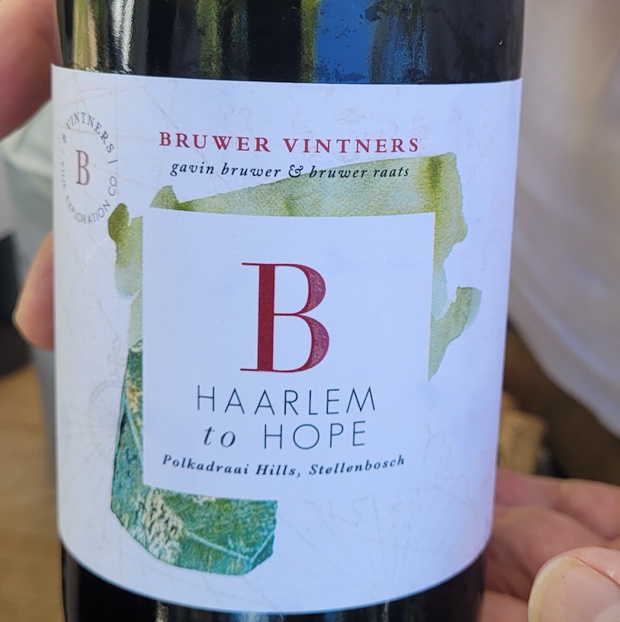
B Vintners Vine Exploration Company “B” Haarlem To Hope 2021, WO Stellenbosch
Cousins Bruwer Raats and Gavin Bruwer Slabbert created Bruwer Vintners Vine Exploration Company in 2014 to celebrate family and Cape heritage through a joint venture. Haarlem To Hope 2021, from the motherland to the Cape of Good Hope, a blend of nearly 70 per cent chenin blanc with just about (30) sémillon plus bits of muscat blanc and muscat d’Alexandrie. All from Polkadraai Hills where Raats’ extraordinary Eden chenin is from. All four blocks of vines are old and Bruwer had to convince a neighbour not to rip them out. The chenin is barrel fermented, the sémillon harvested early and the blend is laden with this amazing glück, a textural component indescribable using any other word. “B” is for everyone involved; Bruwer, Gavin’s mother’s maiden name and the history of the Bruwer Huguenots. Impressed by how this never drifts into oiliness or liquid metals but finds balance between all parts. The texture could be called sumptuous but in any case the two plus two varietal get together walks up and down both sides of a two-way street. Drink 2022-2026. Tasted October 2022

With Sebastian Beaumont
Beaumont Wines New Baby 2019, WO Bot Rivier
New Baby was released in June of this year and 2015 was the first vintage of a truly Cape conceptual wine. It was launched as a way to combine the idiosyncrasies and potentially complimentary personalities of different white grape varieties on the farm. In 2019 the lead is chenin blanc at 40 per cent with (30) sauvignon blanc plus smaller amounts of chardonnay, sémillon and colombard. They were all planted by Sebastian Beaumont’s father from 1974 onwards. The style and notion follow the line established by Hope Marguerite. “My mother said every vintage was like giving birth to a new child,” explains Beaumont. “Once you do something it’s hard to shake.” Yet another brilliant white appellative blend to define the Cape’s idiomatic meets wild west psyche and only in South Africa do the interpretations emerge like this. All in barrel and the vapour trail is palpable, especially in the flint and smoulder that come from the Bordeaux grapes. New Baby pops, piques, kindles and snaps, raises the senses and is just a perfect conceptual creation. Hard not to love this bloody wine. Drink 2023-2030. Tasted October 2022

Christa Von La Chevallerie
Huis Van Chevallerie Springhaas Vin Blanc 2019, WO Coastal Region
Springhaas is the South African hare, a medium-sized terrestrial and burrowing rodent. Despite the name, it is not a hare. Springhaas the white appellative blend is from Voor-Paardeberg, of 40 percent chenin blanc, (33) viura and (27) verdelho. Many winemakers get their “specs” from these vineyards, including Thorne & Daughters. This is Christa Von La Chevallerie’s concept wine but also a signature of who she is. The viura is also used for her Hummingbird sparkling. “It’s from the mountain and people know it,” she says and what she means is this is bloody good juice. “It’s my six dollar version of something fun. Others can play on top of it.” Well it jumps and hops so there’s that, also fine bitters, lime, a fino moment and a sweet brininess that makes you want more. What a fantastic finish, drink enough of it and it goes all refreshing and satisfying. But you’re upset when it’s gone and it makes you realize that you’re also hungry. The chenin from decomposed granite releases the acidity and is the impetus for excitement. Just enough takes the lead to establish balance. Springhaas will have you realize with relief that this is not an invitation to small Pedetidae murder but an alliterative description of an appellative deliveroo. “Here, hare, here.” Drink 2022-2026. Tasted October 2022
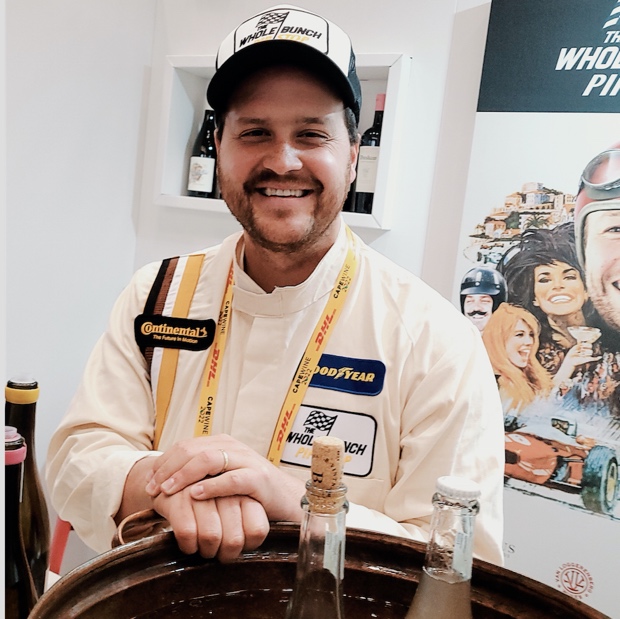
Franco Lourens
Lourens Family Wines Lindi Carien 2021, WO Western Cape
The influence on and reasons are numerous for Franco Lourens to make this white appellative blend. It begins working alongside Chris Alheit and a little wine called Cartology, develops out of a need to pay for an engagement ring, solicits the assistance of old vine chenin, old for South Africa verdelho plus wisened teens named colombard, grenache blanc and palomino. Finally, it’s success and payout get the ring, marries the girl and the wine remembers it all, named after Franco’s bride, Lindi Carien Lourens. The Stellenbosch verdelho (35 per cent), Swartland chenin blanc (21) and colombard (19), Piekenierskloof grenache blanc (18) and 1972 planted palomino (7) are all expertly judged and delineated in 2021. Five days of skin-contact on the GB does just enough to solidify and texturize the entirety but otherwise it’s “lazy winemaking” says Franco for a wine first made in 2016. Oak is old while the package is just as tight and seamless as a WAB can be, especially in the WC. The layers of components really do like one another, that much is obvious and yes, “all my wines have come a long way,” says Lourens. “I try to tighten the bolts and the screws every year.” These are snug in 2021. Indeed. Drink 2022-2027. Tasted October 2022
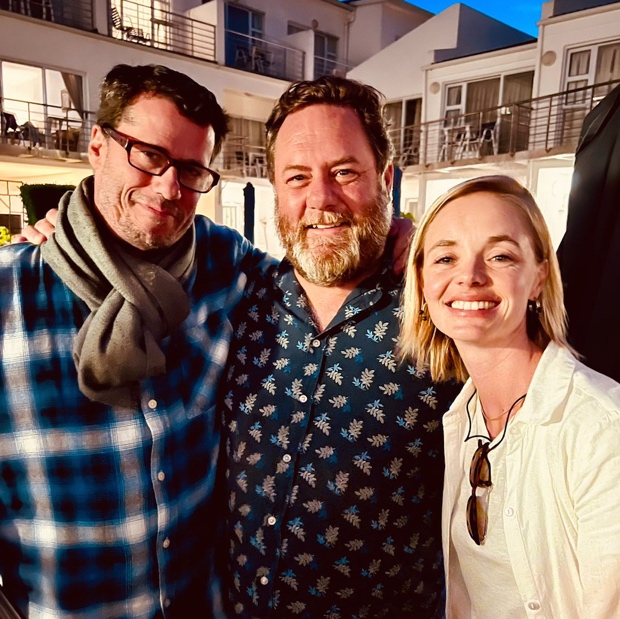
With André Morgenthal and Charla Bosman
Sijnn White 2020, WO Malgas
This 2020 is the first vintage to bring verdelho into the mix with chenin blanc (the OG variety planting in 2004) and roussanne. The Iberian grape takes this intrepid White to a side-stepping, new era level. The first of its ilk and a bit clumsy whilst this young and impressionable but my how this will change perception and forward thinking with respect to Malgas blending. The White iterations from 2017-2019 are stellar wines and represent peak performance for their time. But change and growth are good and necessary, otherwise things get stale, even in this crazy outpost of a wine-growing place. There is much to learn from the 2020 first kick at this new can and there can be no doubt winemaker Charla Bosman will take little time to morph this new identity into something mind-blowing. Drink 2024-2028. Tasted October 2022
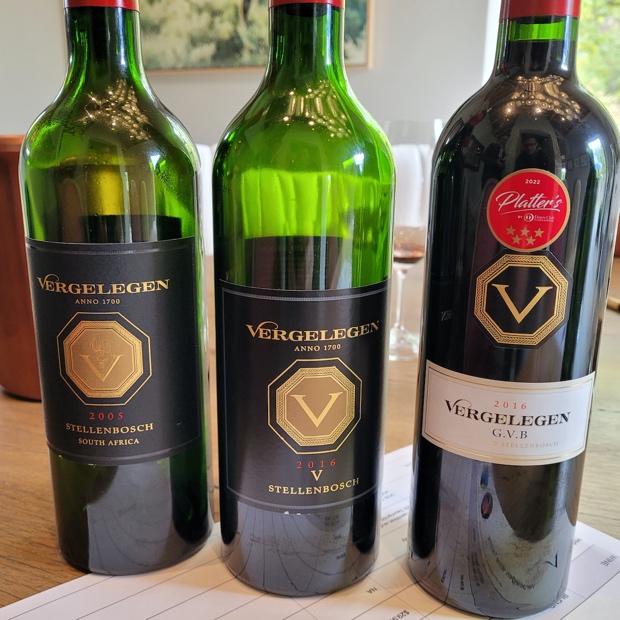
Vergelegen G.V.B. White 2021, WO Stellenbosch
A Bordeaux blend of 78 percent sémillon with (22) sauvignon blanc and likely the most dominant blend in this regard anywhere in the Western Cape. The sém portion is usually 50-60 and here from 2021 the standing firm, upright and out is on fully skeletal display. There can be no mistaking the fynbos and on a grander scale the estate farm in this wine. Peaches and cream dictate the fruit aromatics before the sémillon kicks into pedal to metal overdrive, ushering in resins, essential plant oils and strength of character acidity. This was bottled at the end of 2021 and just recently released. Subsequent vintages will be under the reigns of new winemaker Luke O’Cuinneagain whose track record includes stints at Château Fieuzal, Cave Dietrich, Château Angelus, Screaming Eagle, Rustenberg and Glenelly. Drink 2022-2026. Tasted October 2022

Red Blends
A.A. Badenhorst Kalmoesfontein Red Blend 2021, WO Swartland
Five grape varieties and as Badenhorst is wont to do they are all co-fermented. As a winemaker or in any homestead job you are always influenced by where you grew up and who you worked with. Tells Adi, “in the Swartland these are the varieties that were there.” And so this is Saint-Éstephe meets Cornas, rustic yet pure, ripe and ripped. No make up and it preaches the Badenhorst philosophy. The elévage is 80 percent in concrete with (20) new casks. Turned out to be a pretty tannic vintage, maybe even as a surprise to Adi. “There’s oxygen here.” The most structured of all these wines and clearly one that can age, with thanks to amazing vineyards. Drink 2024-2032. Tasted October 2022
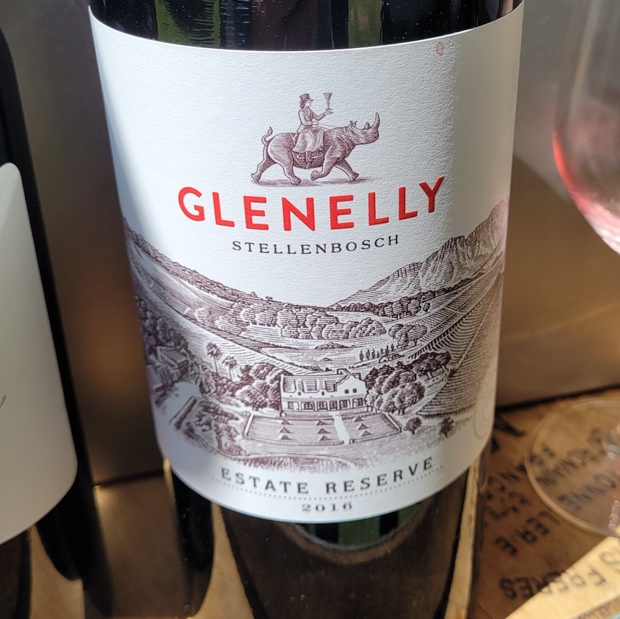
Glenelly Estate Reserve Red Blend 2016, WO Stellenbosch
Based on Bordeaux varieties and the fruit is almost second wine styled as if Lady May the Glenelly grand vin is Paulliac and this Reserve Red is La Croix Ducru Beaucaillou. Or something along those lines. Here we receive top ecehlon Cape cabernet sauvignon with merlot and petit verdot but the side-swiping catalyst is the generous and liquid peppery splash of syrah, the energizer and impetus to really make this Meritage go. Rich and chocolaty, financed and very clever, warm and woollen. Yes it reminds of Bordeaux in Western Cape earth but that syrah changes everything. Or adds actually, activates notions and sentiments only Stellenbosch and environs are want to do. Creates a new yet old-hearted heritage. Drink 2023-2027. Tasted October 2022

Kanonkop Paul Sauer 2019, WO Stellenbosch
Abrie Beeslaar is the winemaker of this Cape icon of a Bordeaux blend in 2019 composed of 75 percent cabernet sauvignon, (14) cabernet franc and (11) merlot. Beeslaar notes that the carry over of drought is still felt through this ’19 pulled from dryland vines aged 30 years on average and growing in decomposed granite, Hutton and Clovelly. Obviously youthful as to the point of immovable but in a modern world Paul Sauer speaks clearly and the vernacular is as understood as it has likely ever been. Tasted alongside the ’91, ’97, ’09 and ’14 you can see a shift in style over the course of nearly three decades or rather an adjustment to keep up with wants and needs. Change does indeed match the times and while this blend is about as structured as any in the Western Cape there are more handsome qualities and even a moment or two of immediacy. Not exactly gratification because the tannins are a force but things seem measurable. The middle palate is full and flavourful, giving off this cool sensation. Many years of excellence lay ahead. Drink 2025-2035. Tasted October 2022

Meerlust Rubicon 2017, WO Stellenbosch
From a drought vintage yet there can be little doubt that in farming these Bordeaux varietal vineyards almost every bunch, however small they may have been, came out fresh and healthy. Rubicon 2017 is all perfume, of violets and berries, currants and Cassis as a by-product of distilling these varieties down. Still youthful and feeling a bit boozy though the complexities and acidities have yet to arrange, layer and align. The intensities are a bit haphazard and there are so many programming features running on overdrive. A look deep back for a comparison might be 1991 and if there is truly a connection then the future for this vintage is so very bright. Drink 2023-2033. Tasted October 2022

Duncan Savage
Savage Wines Red 2020, WO Stellenbosch
Still called “Red” but since 2017 this artist formerly known to blend with grenache, cinsault and touriga nacional no longer seeks that meritage effect. For good reason because the syrah fruit is tops and under this command it transforms into magic. The idea of cuvée persists but the concept is that of mono-layering, single varietal stacking, syrah on syrah upon syrah. The progression come to this makes perfect sense for a signature wine to define what Savage wines is and needs to explain. This wine is unreal, fully formed and seamless, of a structural indemnity that shifts risk from one party to another, from one layer of syrah to another so that the whole is always protected. Might seem or feel like an impossibility but when one part has the back of the rest and the engineering covers the whole, then the architecture is solid. A beautifully tough and grippy syrah is the result, never gritty or swarthy but so very fine-tuned. Drink 2025-2030. Tasted October 2022

Springfield Estate The Work Of Time 2016, WO Robertson
Based on the concept that “time is the lost element in today’s winemaking, can be so precious – yet it is free.” Time for a 1992 planted vineyard to reach a level of maturity to make a great wine and so the first vintage is 2001. Time in barrel and bottle, two plus four, then released with the work having already been done. Ready to drink? Not so fast. Time is not of the essence but for the patient. The grapes are cabernet sauvignon, cabernet franc, petit verdot and merlot for a truth be told in woollen, swarthy and sauvage personality, needing two more years to begin breathing and exhaling the true character of their gathering. Bonded together they will be one flesh and fleshy they will be, fruit and animal, of a vibrancy to speak of cape heritage through red blends. Chalky tannins and high acidity also need to cooperate but in the end this will surely become something really special. Drink 2024-2030. Tasted October 2022

With Eben Sadie and John Szabo MS
The Sadie Family Die Ouwingerdreeks Columella Liberatus In Castro Bonae Spei Vindemia 2020, WO Swartland
Less syrah (40 per cent as opposed to what used to be 80), with grenache and mourvèdre plus more tinta barocca now in Columella. Results in an even firmer, linear, direct in your face and on the palate kind of red blend. Tannic to the bone, a karst now painted on, slowly to weather and be stripped away, eventually to dry as a charcuterie board of salumi, savoury jam and tart pickle. Eben Sadie feels this stylistic cuvée in his bones, down to his core and know this. Big extraction and heavy oak treatment is not part of the program. For the highest degree of complexity accumulated it would be best to hide this ’20 away and return in 10 years. At the very least. Check in after four or five and there will be great reward if not the kind of next level, millennia or epoch. Drink 2026-2037. Tasted October 2022

Agulhas
Varietal Whites
Ataraxia Chardonnay Earthborn 2020, WO Hemel-En-Aarde Ridge
Snap, crackle, dried green apple skin dusted and pop with white pepper bite. Savoury-herbal by a typically endemic site where terroir is clearly the driver for this particular chardonnay. Vineyards of fruit counteracted by salinity. Drink 2022-2025. Tasted October 2022
Bosman Family Vineyards Chardonnay 2021, WO Upper Hemel-en-Aarde
Persistently reductive, brown butter nutty and softly aromatic. The notable (13.9 per cent) alcohol accentuates the 15 per cent settled juice aged in Burgundy barrels for six months to make this feel generously wooded. Richer palate and furthered intensity. Tasted as part of a 15 chardonnay flight in perspective at L’Avenir. Drink 2022-2024. Tasted October 2022

Bouchard Finlayson Chardonnay Missionvale 2021, WO Hemel-en-Aarde Valley
Pure citrus entry, all parts involved, juice, zest and pith. Well lees aged during its tenure with sweet fruit scents, flavours and naturally occurring caramelization. Old school, less cool and yet herbal minty through the mid stage, then ranging quite long and far. One of the more complex chards with depth and warmth provided by the valley floor. Drink 2022-2025. Tasted October 2022

Braai Brekkies in Arniston
Cap Maritime Chardonnay 2020, WO Upper Hemel-en-Aarde
Cap Maritime is the Upper Hemel En Aarde chardonnay work of Boekenhoutskloof’s Marc Kent. A classic cool climate chardonnay, whether by place or vintage, or perhaps a combination of the two. This jumps out as one made in the most wholesome and also dedicated way, smooth and consistent, surely a factor of an estate’s terroir. Perfectly seasoned and reasoned for great effect. Cool all the way. Drink 2022-2024. Tasted October 2022
Creation Chardonnay 2020, WO Hemel-en-Aarde Ridge
Quite buttery and rich, fully formed, styled and developed as chardonnay in a cool yet at times foggy and humid climate. A fine mix of toast and texture, energy and appeal. Drink 2022-2024. Tasted October 2022

Zoo Crü – Cape Wine 2022
Crystallum Chardonnay Clay Shales 2021, WO Hemel-En-Aarde Ridge
Clay Shales is what Bourgogne not called Grand Cru strives for. That would be stage presence, which is a character trait that less than one per cent of the world’s chardonnay can say it displays. Andrew and Peter Allan Finlayson have mined platinum with this 2021 of a what’s in a name codex for Bokkeveld Shale meets clay soil. Single vineyard chardonnay of one hectare producing only 2,000 bottles is deserved of cru status when it takes a producer’s profound to an entirely new level. Hilltop site, windy as fuck and you can sense the breeze blowing through to mitigate and balance an unreal level of richness and concentration. Not just this but an equality by a tautness that commands respect but also relaxes to let the fruit exhale and express. Clay Shales is an important matter of a single Hemel-en-Aarde ward, a ridge supreme upwards and its makers standing two metres tall, upright and looking over the pack. Chardonnay at the pinnacle for Crystallum’s studio work, conveying much without overstatement. It is almost impossible to imagine any Western Cape chardonnay discussion without it. Drink 2024-2030. Tasted October 2022
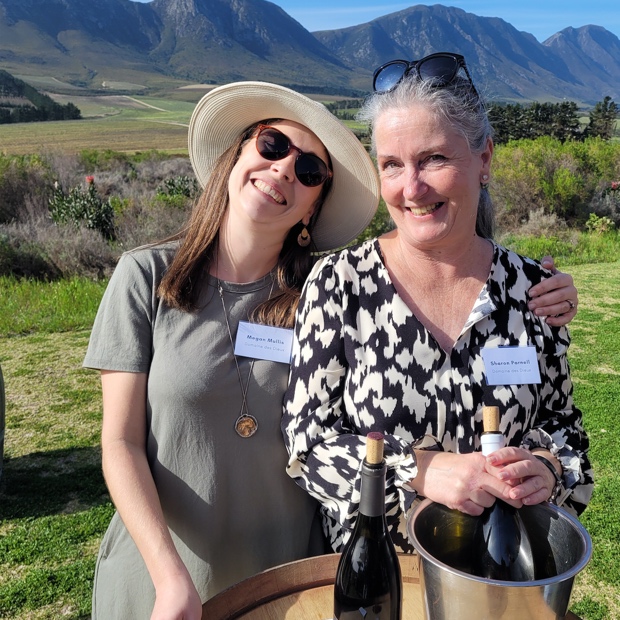
Megan Mullis and Sharon Parnell, Domaine des Dieux
Domaine Des Dieux Chardonnay 2019, WO Hemel-En-Aarde Ridge
The mansion of the gods and can’t help but think of a childhood cartoon memory (Asterix) but there is nothing childish or cartoonish about this splendid chardonnay. By a long shot the most reductive of the 12 thus far in this blind tasting flight. Holding back the years and tears, a chardonnay of deem, deed and demand, explaining little, not interested in giving in, clearly designed for longevity. Impressive and of secrets we wish to know. “Hoping for the arms of mater, get to me the sooner or later, oh.” Drink 2023-2027. Tasted October 2022
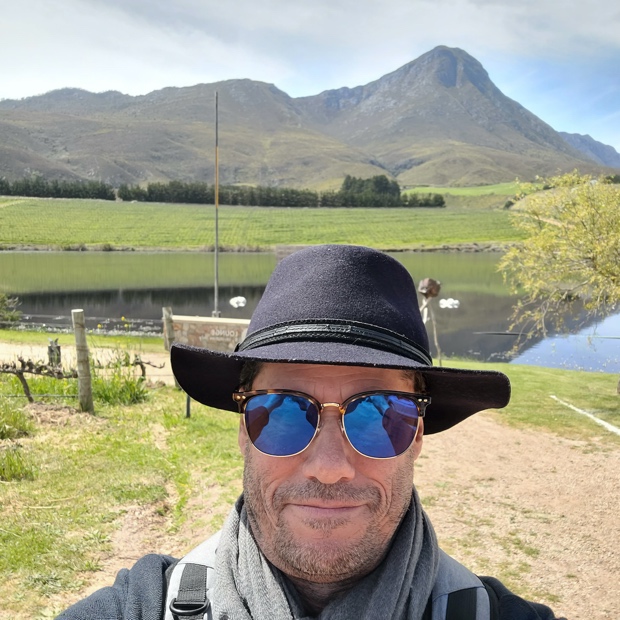
Godello in Hemel-en-Aarde
Hasher Family Wines Chardonnay Marimist 2020, WO Upper Hemel-En-Aarde
Richly aromatic, emitting the perfume of fresh yellow flowers like few in a 15 strong chardonnay flight from the Hemel-en-Aarde. No let down on the palate in fact texturally this lays it all out, with more fruit and wood interaction than most in an evolved, developed and symbiotic way. Fulsome wine, ready, willing and able. Drink 2022-2024. Tasted October 2022

Braai at La Motte
La Motte Sauvignon Blanc Pierneef 2021, WO South Coast
Pierneef, a reference to the well-known painter. Includes 10 per cent sémillon and the earliest vineyards were planted in the 90s. Pinpointed sharpness in sauvignon blanc and although there is a sense of pungency the urgency of freshness and spirit are the shit. Comes from Agulhas in the Cape’s South Coast which is the most southern vineyard in Africa, perhaps the coolest there is in the Western Cape. There is indeed a Sancerre sentiment here but stands apart, alone, of its own accord. From a growing contract of 25 years, rented, a management contract paid and grapes taken. Drink 2022-2025. Tasted October 2022

Christo Kotzé, L’Apogée
La Vierge Chardonnay Apogée 2018, WO Upper Hemel-En-Aarde
Though a 2018 the primary notes prevail in this chardonnay from a cool marine climate. Young vines (eight years of age) on the plateau’s argillaceous Bokkeveld Shale and sea breezes are at the tops of influence. Closed, taut, yes reductive but more so a case of youth, unforgiving and ungiving while in that state. A mildly warming and nutty white caramel indicate change is coming as they carry on and over into a chardonnay expressive of great length. High caste and style though the climax or pinnacle of potential is far from realized. Drink 2022-2025. Tasted October 2022

Natasha Williams, Bosman and Lelie Von Saron
Lelie Van Saron Chardonnay 2021, WO Upper Hemel-en-Aarde
Exceptional and artistically precocious work here at the hands of Natasha Williams, cool and linear, of less barrel than most. A bit taut and tightly wound. Piqued, liquid white peppery, no caramelization, brown butter nuttiness or toast in any shape, style or form. Not the longest finish though also never sharp – nor abrupt neither. Solid construction, plenty of citrus, proper and distinct. Drink 2022-2024. Tasted October 2022
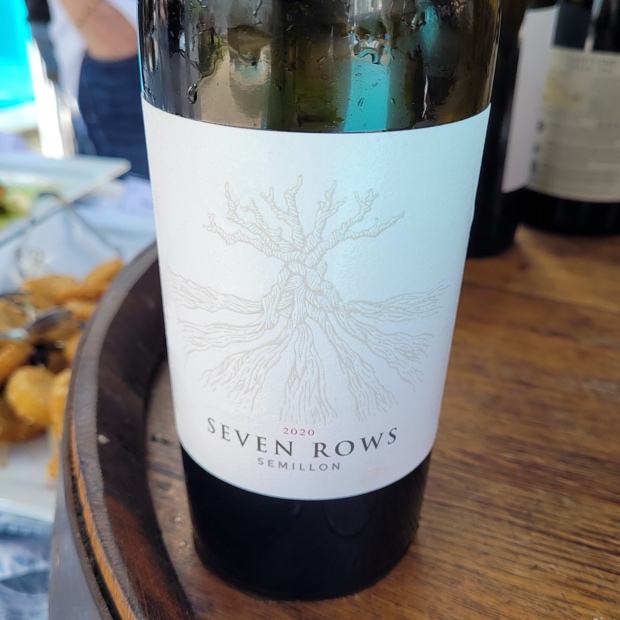
Lomond Wines Sémillon Seven Rows 2019, WO Cap Agulhas
Must be nice to farm and produce in a climate where you can consistently grow and then gift straight sémillon and this from Lomond is about as credible as they come. Obvious richness mixes with herbology in sweetness but most of all the effect comes from barrel fermentation in 500L tonneaux. Lean is not the operative though mineral and elemental surely are, not merely salty but marine influenced at the southern most point on the African continent. It’s something so much more, notorious even, unique, curious and all in. Intensely woven as sémillon will ever get and the real interest is to see how this ages. Great intrigue. Drink 2022-2026. Tasted October 2022

Hemel-en-Aarde
Newton Johnson Family Vineyards Chardonnay 2021, WO Upper Hemel-En-Aarde
Newton Johnson’s is self-professed vibrant chardonnay to rival Bourgogne as well as anywhere in South Africa. Their 2021 raised in the ward of the Upper Hemel-En-Aarde shows so much more than taut mineral activity and is yet so far from anything remotely tropical. Rather it resides on the barrel fermented side of things where fruit richesse and oak fuelled beauty get together in a whirl and swirl of lees and acid, forming a cone of chardonnay in centrifuge, oily and silky at the same time. There are some juicy terpene moments upon tasting and so a disparate moment or two will happen before the warmth of this chardonnay nurtures as it trickles down upon the finish. Feels preserved in great balance and of citrus in oxygenated motion. Drink 2022-2026. Tasted October 2022

Craig Wessels
Restless River Chardonnay Ava Marie 2020, WO Upper Hemel-En-Aarde
To meet and taste with Craig Wessels is to know him because he wears his wines on his sleeve and allows them to do the talking. They in turn speak on behalf of a breeze swept place aboard the plateau of the Upper Hemel-En-Aarde. There is a wee bit of (Tuscan) amphora addition and yet its effect is only sensed in the shadows of this understated chardonnay. Named for Wessels’ daughter with fruit hermetically contained and protected the minute it left the small, profound and single two hectare vineyard. A bit demure, pretty and classic, less ambition and need for immediate recognition but clearly confident without attitude or overt display. Almost convinces of the simple, amenable and how remarkably easy it is to get with, but that is indeed the beauty and subtlety of this wine. Fine wine. Made that much more indelible after tasting a 2015 from Magnum with Wessels over lunch at Hamilton Russell. Drink 2023-2028. Tasted October 2022

Jessica Saurwein
Saurwein Riesling Chi 2022, WO Elgin
CHI is the riesling work of Jessica Saurwein, German-South African, naturalist and champion of both riesling (Elgin) and pinot noir (Hemel-en-Aarde Ridge). The word carries two meanings, translated as “life force” and also the first three letters of CHIUTA, an African rain god. These are spiritual connections that reflect the individualism of the producer and also her wines in the how, where and why they are of a magic produced by the garden. Saurwein’s 2022 is a beautifully balanced riesling of invisible pulse that feels akin to how mushrooms might communicate with one another using electrical impulses. You could imagine attaching a soundboard and speaker through electrodes to the vines to measure spikes in signal activity. Just as a scientist would connect to hyphae and hear them talk. But I digress and in this glass this mix of 11.5 per cent alcohol, 11.5 g/L RS, 7.5 g\L TA and less than 3.0 PH equates to a rich yet linear riesling of full flesh and healthy bones. A riesling aching to explain itself, how it is grounded while also soulful, hovering in weightlessness and ethereal. This may seem like a quiet, standalone organism of a wine but is in fact a complex weave of language transmitting soil, geology and place. It’s really quite special and Jessica Saurwein seems poised to be the Cape winemaker who will translate substrate behaviour with clarity through the language of wine. Drink 2023-2029. Tasted October 2022

Southern Right Sauvignon Blanc 2022, WO Cape Coast
The fruit origins are threefold, as are the soil types. Walker Bay (47 percent), Hemel-en-Aarde (43) and Elgin (10) and a sauvignon blanc layering by way of clay-rich shale, decomposed granite and Table Mountain sandstone. Dry, medium to elevated acidity, low pH and moderate alcohol adds up to marine air freshness and what proprietors Anthony and Olive Hamilton Russell will say is “tensile character and a marked, saline minerality.” The Hemel-en-Aarde Valley contributes as much as any fruit source in terms of having a say, not dominant per se but leading in its confident way. A track record as solid as any of its ilk to deliver an intensity of flavour and that freshness overload, together thick as thieves, drinking at peak, right now. With four-plus years in bottle a next level flinty magic and fruiting genius will occur, like tooth fungi from mycelium when conditions run ideal. The vintage guarantees such a transition into secondary character will happen. Drink 2022-2027. Tasted October 2022

Hemel-en-Aarde
Storm Wines Chardonnay Storm Vrede 2021, WO Hemel-en-Aarde Valley
Vrede is literally “peace,” as chardonnay so named and raised on clay-rich Bokkeveld shale soil in the valley where fog and humidity settle at the lower levels to play a direct role in viticulture and especially the ripening seasoning. The soils are shallow overlaid heavy clay and who could dispute this geology acting vehemently as a factor? Rich and golden, reductive yet apple fleshy yellow and cream textured. Protected beneath a savoury-candied shell then later accented by herbaceous rhizome spice. Continues with ever consistent persistence, unrelenting, direct, linear and perhaps while this youthful also just a bit woolly and wild. Must check this out on repeat for the first three-plus years. Tiny production of just 125 cases (of 12). Drink 2023-2026. Tasted October 2022
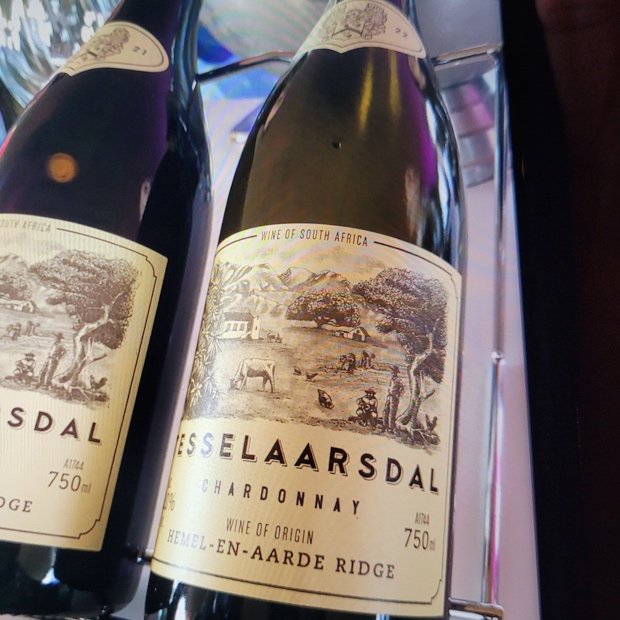
Tesselaarsdal Chardonnay 2021, WO Hemel-en-Aarde Ridge
The juice is up front, the wine opening for immediate gratification, ready and willing to please. Charged though here in a first dimension without any knowable access to further ones available. Quite tart and spirited though on a one way street with a finite finish. Super high acid, early picked and a touch green. Drink 2022-2024. Tasted October 2022
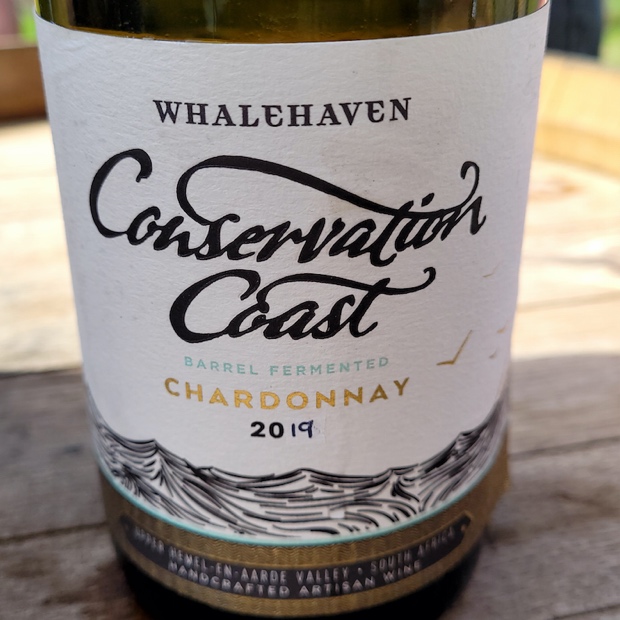
Whalehaven Chardonnay Conservation Coast 2020, WO Upper Hemel-en-Aarde
Slow to reveal, unwind and prepare itself for the great revelation, in tact and a chardonnay of firmness and useful tactility. The kind of tact is so apposite to wines that tack or are in fact tacky as this is anything but. The lees are a bit sticky and so there are some thicker glück moments. Drink 2022-2024. Tasted October 2022

Varietal Reds
Beeslaar Wines Pinotage 2020, WO Stellenbosch
Abrie Beeslaar came from Kanonkop so the acumen with respect to pinotage is more than obvious. Beeslaar works with vines planted at the grape’s origins on the north side of Stellenbosch. There are few if any with this type of natural sweetness in the fruit, with thanks to the pinpointed location on the line of decomposed shale that runs up to Stellenbosch mountain. Passes through this pinotage with peaking fruit power and stone intensity. Despite 40 per cent new oak (and you feel the wood) there is a lovely peeking swarthiness about this pretty wine. Drink 2023-2027. Tasted October 2022

Blackwater Wines Cinsault Zeitgeist 2019, WO Darling
Francois Haasbroek makes use of the same Darling block of fruit as Duncan Savage in his cinsault called “Follow the Line.” This used to be called “Hinterland” but Haasbroek has changed the name to “Zeitgeist” and yes, the definition is equivocated through the idea of Western Cape single-vineyard wines from off the beaten path, small-parcel sites. Recall that “the defining spirit or mood of a particular period of history as shown by the ideas and beliefs of the time” is exactly what winemakers consider and exact from these varietal blocks. Francois goes at it with 60 per cent whole cluster and 100 percent concrete fermentation. Results in notable up front fruit with age-prepared softness and a marbling nearly unrivalled in Cape cinsault. Like protein of perfect ratio turning to butter the moment it hits the heat of the pan, this is the effect that transpires when the wine slides across the palate. Cinsualt of bandwidth from dry-farmed bush vines growing on Table Mountain sandstone for indelible grace. Drink 2023-2028. Tasted October 2022
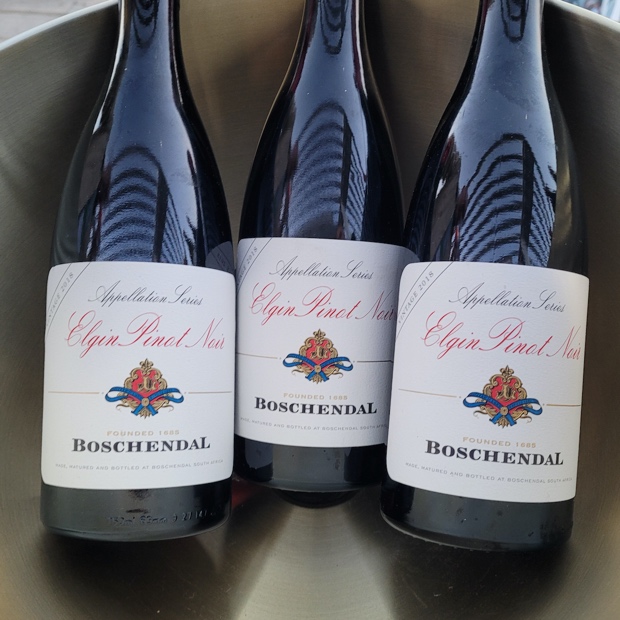
Boschendal Pinot Noir Appellation Series 2020, WO Elgin
Taken from vines growing at 500m on a what’s what of soil types; Heavy red clays, Table Mountain sandstone, Bokkeveld shale, Tukulu and Silica quartz with underlying Kaoline clay. An extreme slope and a place where baboons take what they want and wine is made from the remainder. Serious solar radiation juxtaposed against the coolness of what lays beneath the surface to result in dichotomous pinot noir, blessed of purely Elgin-styled red fruit, richness and tension fighting for supremacy. Earthy enough, element driven, aged in mostly 500L wood, to augment and not infiltrate. Could benefit from another six months of settling. Drink 2023-2026. Tasted October 2022

Jeanine and Mick Craven
Craven Wines Cabernet Sauvignon 2021, WO Stellenbosch
Mick and Jeanine Craven’s cabernet sauvignon grows right next to the chenin blanc site on mainly granite with some clay underneath. Fermentation includes 70 per cent whole cluster; why…why not…wait…with cabernet sauvignon? Mick shoots that mischievous look and that explains the choice because he gets it. He understands his fruit from Karibib Vineyard site planted in 1999 on these Polkadraai decomposed granites. The whole bunch number was far less in 2020 so maybe if he knew then what he knows now it would have been higher. Maybe not. Notable stem savour but one so piquant, toothsome and then a woolliness but one subtle enough to speak in just a whisper. There feels a syrah comparison but deliciousness in this cabernet comes without iron and closed fisted punches. Kind of Loire franc in its verdant character but again, there really is no reference, nor sauvignon connections neither. Clocks in at a low, low 12.5 per cent alcohol that only the Western Cape can effect for this grape variety while still delivering ripeness, generosity and peace of mind. Another bit of voodoo magic from a place and a maker that knows what’s what. The conclusion? Finesse. Drink 2023-2029. Tasted October 2022

Gabriëlskloof Syrah Whole Bunch 2021, WO Bot Rivier
Now in the hands of Hemel-en-Aarde’s Peter Allan Finlayson of Crystallum and the third vintage of treating Bot Rivier syrah to all in, whole bunch fermentation. All the perfumes that can be pulled might just fill up a small room to do for syrah what only this place can in fact do. The carbonic maceration lasted for ten days before being pressed, taken off the lees and aged in steel tanks for eight months. Clarity, purity and aromatics flown off the charts. You can decide what they are to you but know their omnipotence will draw full attention. Creates a magically sweet, succulent and serious elixir, pretty and poetry in motion, serving up the Bot with sultry sensations. Quite something really. Drink 2023-2026. Tasted October 2022

With Anthony Hamilton Russell and Johan Reyneke
Hamilton Russell Pinot Noir 2021, WO Hemel-En-Aarde Valley
It has come to the point where we want to distinguish stylistic differences between Ridge, Valley and Upper in the Hemel-en-Aarde and if any pinot noir is capable of creating some kind of definition than Hamilton Russell’s would be the one. From 2021 this feels like a light and ethereal kind, tight and restrained but not backward, which can always be a possibility. Valley pinot is less obvious, slower to reveal, incrementally opposite to the Ridge and apposite to the Upper, both of which are showier, less complex and quick to speak. Anthony talks about less solids being left in the tank (since the mid to late 2000s) to result in a greater ability to diversify in barrel. The great solids epiphany came in 2020, 10 years after the “malo epiphany.” When the Ridge pinots show more persistent tannic structure it can create wines of disparate character while the Upper will usually offer the most perfumed intensity. This is more aromatic than most from HR, gorgeous even, as “Burgundian” as ever there has been. Yet Hamilton Russell from the Valley seeks equanimity and slow maturation, never peaking too early or looking to deliver immediate gratification. Patience is the request, even in a “lighter” vintage. This from ’21 is no exception. Drink 2024-2029. Tasted October 2022
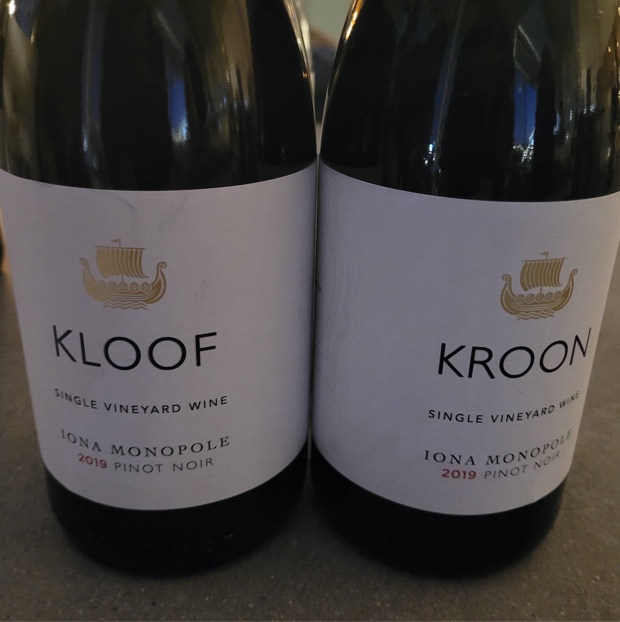
Iona Pinot Noir Kloof Monopole 2019, WO Elgin
Andrew Gunn’s Kloof single-vineyard is the only one on the mountain and he alone makes this Elgin pinot noir from that fruit, thus the Burgundian monopole terminology. There are 12 blocks planted in 1998 and 2010 overlooking the Atlantic Ocean so the wind effect is more than imagined to create the taut tightest, finessed and saltiest on the local (and very parochial) scene. When pinot acts this alive it opens your eyes, nose and palate to a vitality capable of inducing invigoration. A fine example at elevation no doubt with great promise and eventually elegance with thanks to Iona’s focused attention and listening to the winds. Drink 2022-2026. Tasted October 2022
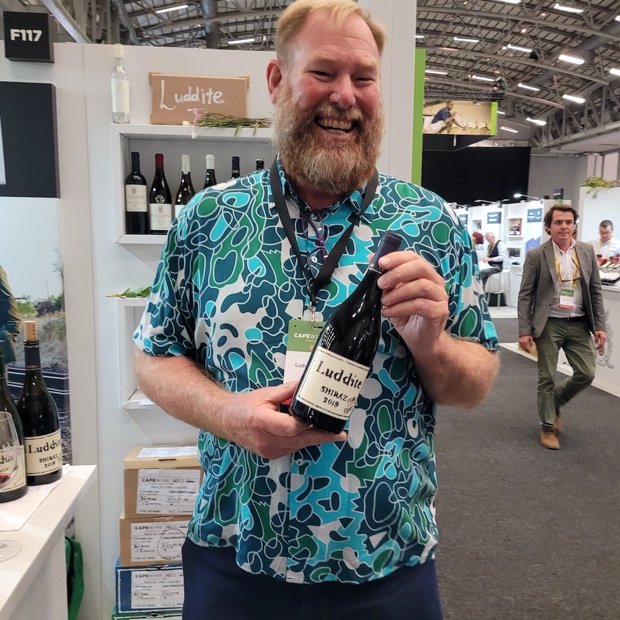
Niels Verburg
Luddite Shiraz 2019, WO Bot Rivier
This is the 20th vintage for Niels Verburg’s Luddite shiraz and what he calls “a survivor.” Each time it arrives there is this newfound, newly generated freshness in revival, no matter the season. The 2019 is the last of the drought vintages from which only 5,800 bottles were made for a sku that can be as high as 30,000. Garrigue aka Fynbos, iodine, Velddrif salts, Imphepho and Nasturtium. Lively and jumps right out of the glass. “Quintessential vintage,” smiles Verburg, released a bit early “but this ’19 is really good.” Producers who do it right work this way and this one reels you in though is surely also age worthy. Drink 2023-2032. Tasted October 2022
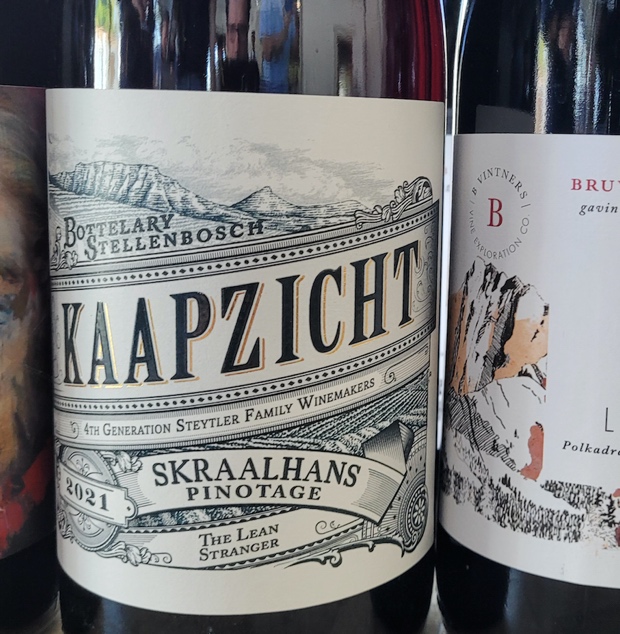
Kaapzicht Pinotage 2021, WO Stellenbosch
Known for a more traditional style, heavy and round, self-professed by winemaker Danie Steytler. Jokes aside this from Bottelary Road is indeed a dense and thickly consummate pinotage, liquid chalky and structured for a long, slow-cooked and extended warranty. Not that Steytler is trying to coax, extract and demand too much but place and climate do conspire anyway. The endgame is far away, for now embittered in black liquorice and taut intensity. Drink 2024-2029. Tasted October 2022

Restaurant at Kleine Zalze
L’Avenir Wine Estate Pinotage Single Block 2020, WO Stellenbosch
From winemaker Dirk Coetzee, from a registered single vineyard planted in 1994. Smooth, refined and swelling with ample tannin. The more “Bordeaux” within the pinotage pantheon, of graphite and Ribena, a righteous greenness, modern perhaps yet earthy, already showing some soy, balsamic, fungi and truffle. Drink 2022-2025. Tasted October 2022

With Marlise Niemann
Momento Wines Grenache Noir 2020 WO Swartland
This grenache noir is Momento’s OG because Marlise Niemann worked in Spain and in 2010 decided to put her faith in this grape. As always low yielding bush-vines in the Swartland grown on its ancient decomposed granite soil are the source and there are few Western Cape examples as beautiful as this. Any origin for that matter because Niemann and the Paardeberg have become soulmates and her choice of one-third whole bunch pressing is spot on. Creates a crust or barque on top of the ferment that carries through to the wine. Cold soak of four days and punchdowns exaggerate the sweetest fruit of sing-song temperament, a varietal Carole King, woven tapestry of longing and love. If you need a restart of your joie de vivre than this is the wine to pour. Aside from its undeniable winemaking genius, the grenache noir endures for its balance between place and adventure, as well as remaining grounded through its maker’s independence and relationship with the Swartland. Drink 2023-2028. Tasted October 2022

Mullineux Syrah Granite Jakkalsfontein 2020, WO Swartland
Jakkalsfontein, “where the dogs spring,” perhaps eternal because granite soils are a gazillion years old and the Mullineuxs have been working with the vineyard since 2014. Whole cluster to the max, open top large vats allowing release and punchdowns keeping that elusive concept of stems working in the success side of trial and error. After that it’s all about tannin polymerization and then refinement. Grandstanding tannins indeed, a vintage of manyfold layers, of warm days and cool nights especially towards harvest, where acid will improve upon tannin . Will be most interesting to watch this one age. Should be a grand granite year. These are true Swartland tannins. Drink 2025-2033. Tasted October 2022
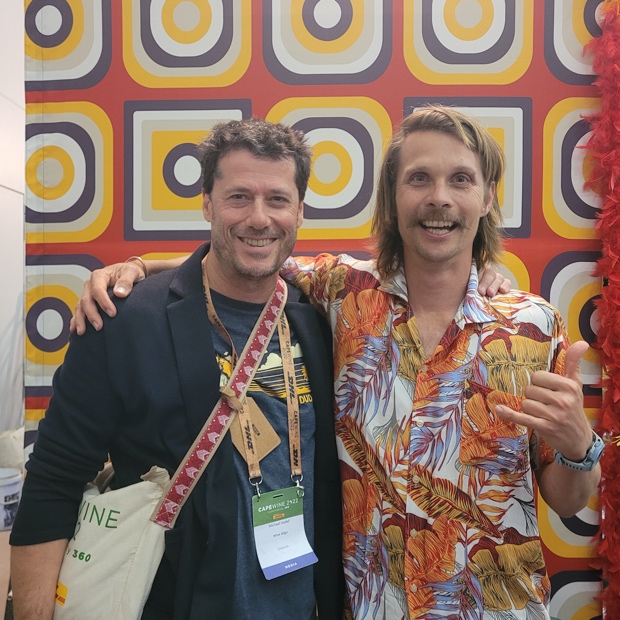
With Alex Milner
Natte Valleij Cinsault 2021, WO Stellenbosch
In 2018 I tasted four different cinsault from Alex Milner and at the time the Darling stood apart. Feels like four years later he has grown to fully appreciate this 1972 Stellenbosch vineyard with deeper understanding and cinsault intuition. This site with its views of Table Mountain and False Bay is picked the latest and in 2021 finished at a mere 11.5 percent alcohol. It is the litheness of glycerol and grace in texture over the palate that makes this far from conventional cinsault tick. That is where the magic happens with thanks to concrete “barrel” aging and guaranteed freshness captured. Tannins are whispers, sweet nothings that melt in the mouth upon contact though they will linger for a few years yet. As soft spoken a cinsault as there is, even by Western Cape standards. Drink 2022-2026. Tasted October 2022
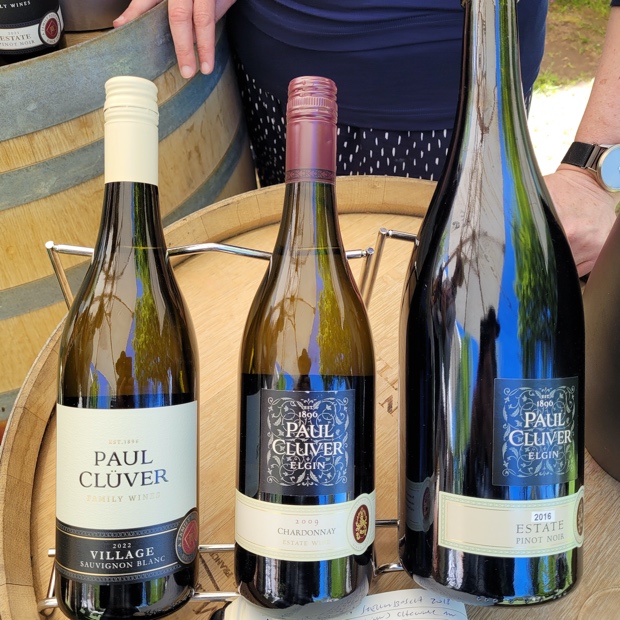
Paul Cluver Pinot Noir Seven Flags 2015, WO Elgin
Increasingly considered a great vintage in Elgin, backed up by this showing at seven years of age. The 115 grows on shale with Koffieklip and in ’15 the whole bunch number was 50 percent. Settled now and in a most ideal drinking way, with nearly five years remaining for more expressive things to say. Last tasted October 2022
The most floral vintage of the Seven Flags and the first with clones 115 and 667 brought into the blend. This to create new concepts and levels of complexity with vines old, new and next level involved. The intermixing leaves us with a sensation involving many layerings; fruit, acid and structural. The fruitiness and fresh flower gatherings presents an aperture of severe harmony and adds up to a bunch of aesthetic yeses. Give it a year or two to integrate. Drink 2020-2027. Tasted September 2018

Porseleinberg Syrah 2020, WO Swartland
It begins with a right proper rant from farmer, BBQ smoker and winemaker Callie Louw. “We don’t need to offset climate change with varietal adaptation. We just need to farm better. The problem doesn’t go away. Cover cropping, activate your place, get things growing, the whole profile is run in the top four inches. Below is the bank, the reservoir. The thing that makes the money is on top. Stop tilling. Leave that stuff on the top of soil. it just burns. Keep the active things alive. Increase the carbon in your soil by one per cent and the water will increase by 50.” Then to the current release at hand. Porseleinberg syrah 2020 is aged in 90 percent foudre and (10) concrete egg. “A nice vintage,” says Louw, “still stuck in a drought but the first year with average rainfall, just about 400mm.” Healthy canopies, just right there, picking without stress. From 2020 about 70 per cent is from one site and while the soils are consistent, the aspects, gradients and all else bring minor variegation, seasoning and spice.“The success of this is a complete fluke. I literally do nothing with the grapes. I realize I do fuck all.” And yet the consistency of the process prevails; of working with syrah like this, whole bunch, no pump-overs and just a belief in the farming. Not sure many 2020s are the shit but this folks and my friends is. South African wine is not all the same. Drink 2020 sooner, the delicious factor will ride. Drink 2024-2032. Tasted October 2022

Bruwer Raats
Raats Family Wines Pinotage Liberte 2020, WO Stellenbosch
From Polkadraai, picked early to help establish a deeply South African sentiment or even manifesto that allows pinotage to separate itself and announce its uniqueness as a wine unlike anywhere else in the world. These are the thoughts of Gavin Bruwer Slabbert. If you attempt to compare this to a Raats cabernet franc there are so few similarities and in fact here pinotage gains stature, swagger and momentum in ways the Bordeaux family of varieties can only wish for. At what cost you ask and that is a worthy query. Traditional beauty perhaps but even pinotage’s lies in the eyes of the beholder. Thick skins and fleshiness abound to announce their estimable arrival. Drink 2023-2028. Tasted October 2022
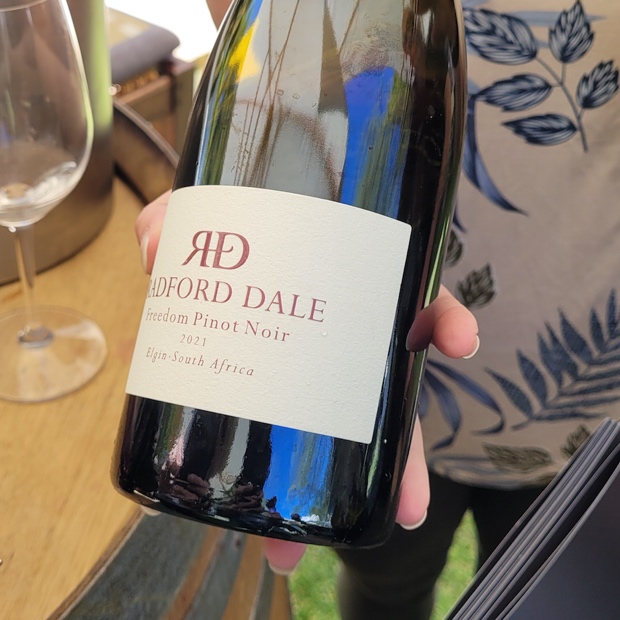
Radford Dale Freedom Pinot Noir 2021, WO Elgin
Proprietor Alex Dale takes inspiration from Nelson Mandela’s memoir “A Long Walk to Freedom” as he sees his adopted South Africa as the place where agriculture and winemaking have given him his. The first organic pinot noir from this Elgin outpost for Stellenbosch producer Radford Dale and what winemaker Jacques de Klerk calls “a transitory vintage.” Meaning Elgin Ridge was the original owner and the farming is now fully under RD’s command. This ’21 is glaring and striking in primary freshness, so youthful it feels like bottling happened only yesterday. Chalky tannic, of a formidable density but stone cold salty, like Sonoma Coast and a wedge of Délice de Bourgogne. This is, in the parlance of our times endearingly referred to as “C’est bon, fuck!” Drink 2024-2028. Tasted October 2022
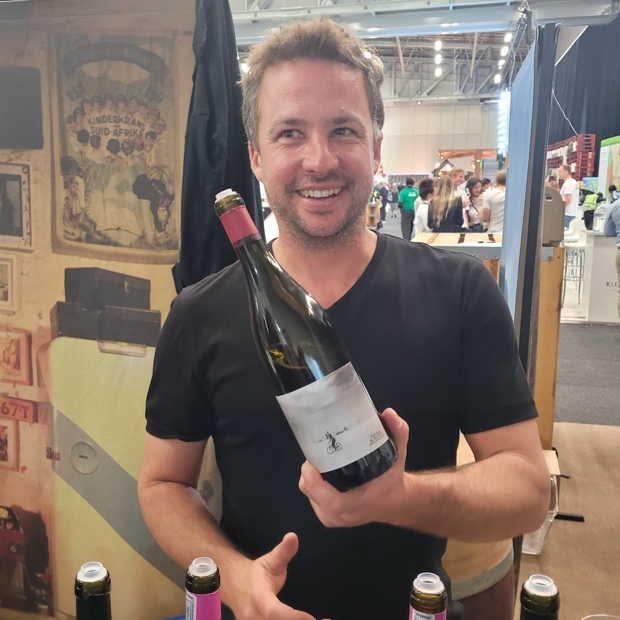
Testalonga El Bandito Mourvedre Monkey Gone To Heaven 2021, WO Swartland
Craig and Carla Hawkins make many skus, almost all small lot from the Swartland and it feels like there is no true rhyme or reason to the portfolio. That is why Monkey Gone to Heaven is the poster for their work, a Pixies song reference Black Francis (Frank Black) has said was named because it “just sounds neat” and also “it wasn’t like we thought we’d get played on the radio.” Perhaps Craig (aka El Bandito) approaches his work in a similar way. Hawkins goes at is as natural as anyone out there but believe it when he insists he’s simply making wine from grapes. What do people think? Whatever. Are the wines niche, raw or mainstream? Don’t really know. Making a statement on environmental concerns? Probably not. We do know this varietal mourvèdre is 100 per cent whole bunch fermented for nine days in open tanks, pressed and aged in 500L foudres. Wild and full on ambient malolactic fermentation. The winking winemaking equivalent of “If man is five…Then the devil is six…Then God is seven.” Actually less intense and grippy than the Queen of Spades Tinta Amarela and also surprisingly perfumed. Even a bit pretty, of different aromatic and volatile lift, apposite in structure, soliciting an arousal of trenchant imagination. What is this? Sarcasm, Kaballah and good grapes. Drink 2023-2026. Tasted October 2022
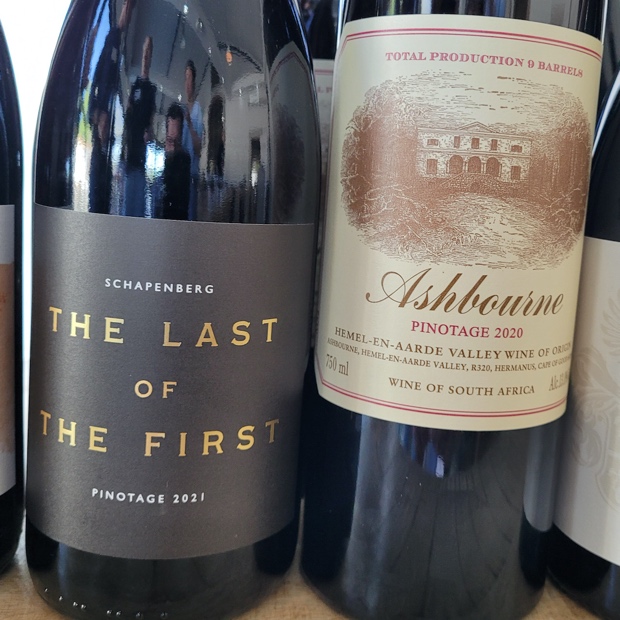
Waterkloof Wine Estate Pinotage Last Of The First 2021, WO Stellenbosch
“We like to make wine we like to drink,” tells Nadia Barnard-Langenegger, based in Somerset West. The block for this wine is part of the first commercial one planted in South Africa, on a cool, east-facing bush vine block planted in 1994 to clay and some decomposed granite. In conversion to organic. “I want to taste what I taste in the vineyard, stones and freshness.” The name is Last of the First because there are no others planted on the Skurfberg. Another terrific example of the new pinotage of flesh, savour, lithely bitter liquorice and high acidity. Definite quality once again. Drink 2024-2027. Tasted October 2022
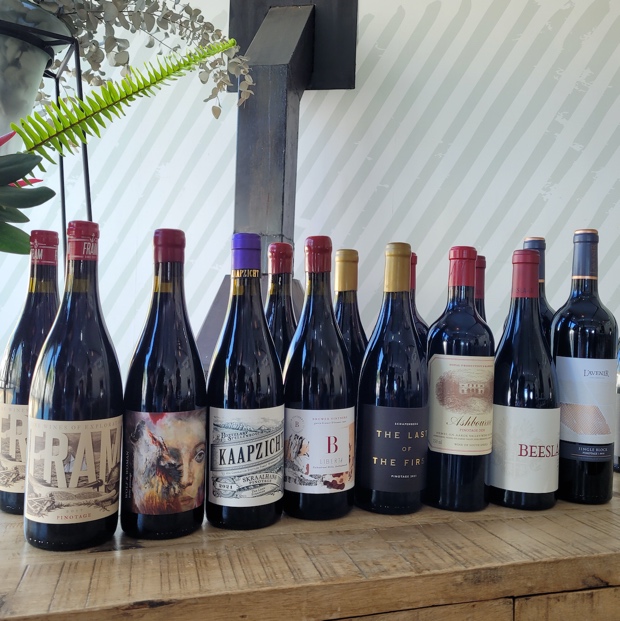
Wolf And Woman Wines Pinotage 2021, WO Swartland
From Jolandie Fouché and old vines planted in 1973 on truly sandy (meaning zero clay) Paardeberg soils. Fouché’s journey has run the gamut, from matriculating to earning her stripes in the South African industry. And one of her dogs is named cinsault. “Sometimes I’m more wolf than woman and I need to stop apologizing for my ways.” Hers is a most perfumed pinotage, thanks to bush vines with big canopies whereby the vine is mostly in the shade, that and more than ample whole bunch fermentation in a carbonic vein. Less oxygen and no new wood lengthen, extend and create a drift that so few wines of this idiom are able to achieve. WAWW is pinotage of elegance incarnate, not without inherent tannin, yet silken no doubt. Drink 2024-2028. Tasted October 2022
Good to go!
godello

Hemel-en-Aarde
Twitter:
Instagram: mgodello
WineAlign


































































































































